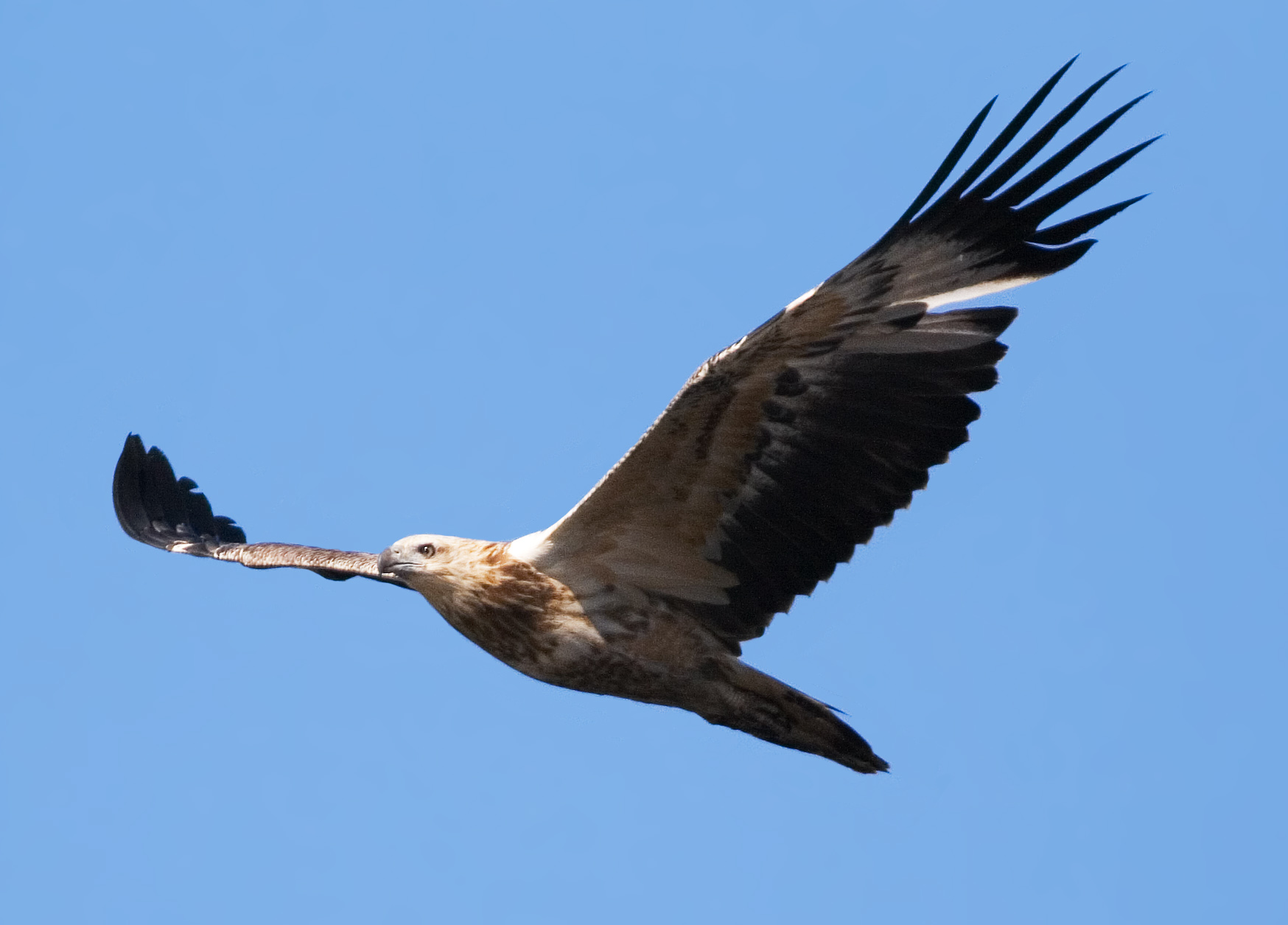Speak

Sometimes he sounds like music to her ears. Other times, not so much.
as an undergraduate at Emory University. For male birds listening to another male’s song, it was a different story: They had an amygdala response that looks similar to that of people when they hear discordant, unpleasant music. The study, co-authored by Emory neuroscientist Donna Maney, is the first to compare neural responses of listeners in the long-standing debate over whether birdsong is music. “Scientists since the time of Darwin have wondered whether birdsong and music may serve similarpurposes, or have the same evolutionary precursors,” Earp notes. “But most attempts to compare the two have focused on the qualities of the sound themselves, such as melody and rhythm.” Earp’s curiosity was sparked while an honors student at Emory, majoring in both neuroscience and music. She took “The Musical Brain” course developed by Paul Lennard, director of Emory’s Neuroscience and Behavioral Biology program, which brought in guest lecturers from the fields of neuroscience and music. “During one class, the guest speaker was a composer and he said that he thought that birdsong is like music, but Dr. Lennard thought it was not,” Earp recalls. “It turned into this huge debate, and each of them seemed to define music differently. I thought it was interesting that you could take one question and have two conflicting answers that are both right, in a way, depending on your perspective and how you approach the question.” Perhaps your brain would enjoy some music while reading this. Here's a sample of Earp's favorite: "Firebird." As a senior last year, Earp received a grant from the Scholars Program for Interdisciplinary Neuroscience Research (SPINR), and a position in the lab of Maney, who uses songbirds as a model to study the neural basis of complex learned behavior. When Earp proposed using the lab’s data to investigate the birdsong-music debate, Maney thought it was a great idea. “Birdsong is a signal,” Maney says. “And the definition of a signal is that it elicits a response in the receiver. Previous studies hadn’t approached the question from that angle, and it’s an important one.” Earp reviewed studies that mapped human neural responses to music through brain imaging. She also analyzed data from the Maney lab on white-throated sparrows. The lab maps brain responses in the birds by measuring Egr-1, part of a major biochemical pathway activated in cells that are responding to a stimulus. The study used Egr-1 as a marker to map and quantify neural responses in the mesolimbic reward system in male and female white-throated sparrows listening to a male bird’s  
"Bullfinch male" by © Francis C. Franklin / CC-BY-SA-3.0. Licensed under CC BY-SA 3.0 via Commons.
a new study by According the late Nicolai Jurgen and researchers from the University of Kaiserslautern in Germany, the analysis of human melody singing in bullfinches gives insights into the songbirds' brain processes. The songs of free-living bullfinches are soft and contain syllables that are similar to the whistled notes of human melodies. Teaching birds to imitate human melodies was a popular hobby in the 18th and 19th centuries and the bullfinch was the favourite species. Using historical data recorded for 15 bullfinches, hand-raised by Jurgen Nicolai between 1967 and 1975, the researchers studied whether the bullfinches memorized and recalled the note sequence of the melodies in smaller subunits, as humans do, or in their entirety, as a linear chain, which is much simpler. They also analyzed the accuracy of the bullfinch's choices and how a bird continues to sing after the human partner pauses. They focused
"Pyrrhula pyrrhula -Lochwinnoch, Renfrewshire, Scotland-8" bi Mark Medcalf - Bullfinch Uploaded by snowmanradio. Licensed unner CC BY 2.0 bi wa o Wikimedia Commons.
on whether the bird chooses the right note sequence at the right time - so-called alternate singing. When birds sing solo, they do not retrieve the learned melody as a coherent unit, but as modules, containing much smaller sub-sequences of 4-12 notes. The researchers investigated the cognitive processes that allow the bullfinch to continue singing the correct melody part when its human partner stops. They found evidence that as soon as the human starts whistling again, the birds can match the note sequence they hear to the memorized tune in their brain. They anticipate singing the consecutive part of the learned melody and are able to vocalize it at the right time when the human partner stops whistling. The authors said that the Bullfinches can cope with the complex and demanding cognitive challenges of perceiving a human melody in its rhythmic and melodic complexities and learn to sing it accurately. The work has been published online in Springer's journal Animal Cognition. (ANI). Source: Article, Golden Whistler Australia Birds: The Norfolk Island subspecies 
of Golden Whistler prefers the shrubby understorey of rainforest, palm forest and local pine forest (Smithers and Disney, 1969), but also uses plantations of exotic species. It has been recorded in, or at the edges of, pockets of suitable habitat throughout the island, but does not occur near gardens (Schodde et al., 1983). There are about 70 other subspecies in other parts of Australia and on islands in the south-west Pacific Ocean. P. p. contempta (Lord Howe I.) is Vulnerable. All other Australian subspecies (Schodde and Mason, 1999) are Least Concern, including P. p. queenslandica (wet tropics), P. p. pectoralis (central Queensland to northern New South Wales), P. p. youngi (south-eastern mainland Australia), P. p. glaucura

(Tasmania) and P. p. fuliginosa (mallee regions). Largely confined to the Norfolk Island National Park and nearby forested areas. A steady decline recorded through 1960s and 1970s, but subspecies still present over nearly half the island in 1978 (Schodde et al., 1983). By 1990, virtually confined to Norfolk Island National Park (Bell, 1990) and the population reduced to 535 pairs (Robinson, 1988). Recent estimates suggest the population has now stabilised (Robinson, 1997). Much suitable habitat has beencleared or fragmented, and the subspecies appears to be confined to
the largest tract of remaining forest. The reason for the recent population decline, and the principal continuing threat is probably predation by Black Rats Rattus rattus (introduced in the mid 1940s; Robinson, 1988). Cats may also take some birds (Bell, 1990). The Golden Whistler lives in forests throughout Lord Howe I., and nests high in the trees away from most predators. Golden Whistlers have survived the introduction of cats, rats, pigs and goats to Lord Howe I. Therestricted area of occupancy, however, makes the subspecies susceptible to catastrophe, such as the introduction of another predator. Source: Article. Doing the math for how 
A baby house finch and its father. Just like humans, baby birds learn to vocalize by listening to adults.
songbirds learn to sing: By Carol Clark, Scientists studying how songbirds stay on key have developed a statistical explanation for why some things are harder for the brain to learn than others. “We’ve built the first mathematical model that uses a bird’s previous sensorimotor experience to predict its ability to learn,” says Emory biologist Samuel Sober. “We hope it will help us understand the math of learning in other species, including humans.” Sober conducted the research with physiologist Michael Brainard of the University of California, San Francisco. Their results, showing that adult birds correct small errors in their songs more rapidly and robustly than large errors, were published in the Proceedings of the National Academy of Sciences (PNAS). Sober’s lab uses Bengalese finches as a model for researching the mechanisms of how the brain learns to correct vocal mistakes. Just like humans, baby birds learn to vocalize by listening to adults. Days after hatching,

A Bengalese finch outfitted with headphones. Research on how the birds learn to sing may lead to better human therapies for vocal rehabilitation.
Bengalese finches start imitating the sounds of adults. “At first, their song is extremely variable and disorganized,” Sober Young birds, and young humans, make a lot of big mistakes as they learn to vocalize. As birds and humans get older, the variability of mistakes shrinks. One theory contends that adult brains tend to screen out big mistakes and pay more attention to smaller ones. “To correct any mistake, the brain has to rely on the senses,” Sober explains. “The problem is, the senses are unreliable. If there is noise in the environment, for example, the brain may think it misheard and ignore the sensory experience.” The link between variability and learning may explain why youngsters tend to learn faster and why adults are more resistant to change. “Whether you are an opera singer or a bird, there is always variability in your sounds,”
 
known as a parakeet in America), was accepted into the 1995 Guinness Book of World Records as "the bird with the largest vocabulary in the world." He was acknowledged as having 1,728 wordswhen the Guinness Book went to press. The documentation for his feat took place over a six-month period when 21 volunteer observers in 21 separate sessions took notes on what they heard Puck say. Several observers were members of the Redwood Empire Cage Bird Club (Sonoma County, California), and most were familiar with various species of parrots. Two of the volunteers were avian veterinarians. In addition to the volunteer observations, tape recordings and a video were provided as documentation for Guinness. Puck's owner/caregiver, Camille Jordan, of Petaluma, California has about 30 hours of Puck tape recordings, videos and detailed records of every word she heard spoken! Puck appeared on several Bay Area newscasts in December 1991 after an article was written about him in American
Cage-Bird Magazine. Another article about Puck appeared in Bird World (Vol. 15, No. 6, 1994). Rather than just mimicking, Puck created his own phrases and sentences. He often used the appropriate phrase in a situation, and sometimes displayed an uncanny understanding of his environment. For example, on Christmas morning, 1993 Puck was entertaining himself on the coffee table in the living room when Camille and her husband heard him say: "It's Christmas. That's what's happening. That's what it's all about. I love Pucky. I love everyone." Unfortunately, Puck's life was too brief. He was only five years old when he died of a gonadal tumor on August 25th, 1994(rip). He had been accepted into the Guinness Book only a few months earlier. Puck appeared in the 1995-8 Guinness Books, was omitted from the 1999-2002 editions and reappeared in the 2003-4 editions. The 2005 paperback Guinness Book has not been released at the time of this writing. Readers should note that record holders will not necessarily appear in every Guinness Book!" Source: Article. Birds and babies learn to  ‘talk’ similarly: study: Scientists have found compelling evidence that birds and human infants learn to string syllables together in roughly the same way: through stepwise improvement. A team of researchers from Japan, Israel and the US has described how they taught songbirds to sing a new tune and compared an analysis of the results with sounds made by human infants saved in a database. The process that allows humans to learn to talk as they move through various stages of development has been a research focus. Source: Article, Image. Amazing Talking Birds: Some people want a pet so they can exercise and play with, Still other people 
want a companion -- an animal that will be an unquestioning, faithful through thick and thin. That's all good for them, but there are those of us who want a companion that we can talk to. We want a voice at the end of a long work day welcoming us home with, "Hello, darling, how was your day?" For people who wish to have that type of companion in the form of an animal, a talking bird fits the bill very nicely. However, not just any talking bird will do. Some birds speak quietly, while others will scream at the top of their lungs. The type of bird one chooses must be paired suitably with the environment in which one lives. That is, house or apartment, metropolitan or suburban. At any time of day. But, perhaps you live in the countryside and the only audio comfort that needs to be taken into consideration is your own. In that case, you will need to decide how much noise you can handle through the day. All talking birds are great fun to have as companions, but some are better at verbalizing and enunciating their words than others. Some species have better memory than others and are able to store hundreds, even thousands of words into their little bird brains. Then there are the select few, like the African Grey, that are able to listen to people talk, discern the proper context and situation, and hold a reasonable conversation (reasonable within the context of being a bird). There are even birds that will break out of their norm and surprise everyone with its highly capable memory and language skills. It is those bizarre birds that are often showcased on shows like Animal Planet. For this list, we based our picks on the special skills of species within the bird classes.
 (9) Budgerigar — The budgerigar (Melopsittacus undulatus), also known as common pet parakeet or shell parakeet and informally nicknamed the budgie, is a small, long-tailed, seed-eating parrot. Their voice tends to be low and not always defined, and males tend to train better than females. Budgerigars are the only species in the Australian genus Melopsittacus, and are found wild throughout the drier parts of Australia where the species has survived harsh inland conditions for the last five million years.Budgerigars are naturally green and yellow with black, scalloped markings on the nape, back, and wings, but have been bred in captivity with colouring in blues, whites, yellows, greys, and even with small crests. Budgerigars are popular pets around the world due to their small size, low cost, and ability to mimic human speech. The origin of the budgerigar's name is unclear. The species was first recorded in 1805, and today is the most popular pet in the world after the domesticated dog and cat. The budgerigar is closely related to the lories and the fig parrots. They are one of the parakeet species, a non-taxonomical term that refers to any of a number of small parrots with long, flat and tapered tails. In both captivity and the wild, budgerigars breed opportunistically and in pairs. Source: Article. 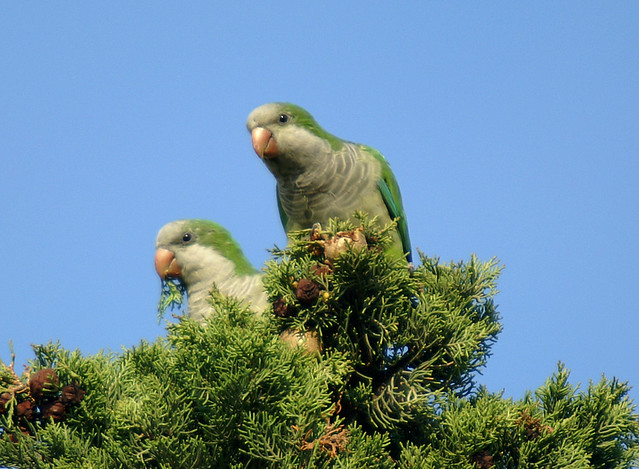 (8) Monk Parakeet — Also called the Quaker Parakeet (Myiopsitta monachus), is a species of parrot, this colorful little bird is actually a small parrot. They are known for being very clever and social, developing large vocabularies of phrases and words. in most treatments the only member of the genus Myiopsitta. It originates from the temperate to subtropical areas of Argentina and the surrounding countries in South America. Self-sustaining feral populations occur in many places, mainly in North America and Europe. The nominate subspecies of this parakeet is 29 cm or 9 to 11 in long on average, with a 48 cm wingspan, and weighs 100 g. Females tend to be 10-20% but can only be reliably sexed by DNA blood or feather testing. it has bright green upperparts. The forehead and breast are pale grey with darker scalloping and the rest of the underparts are very-light green to yellow. smaller Source: Article 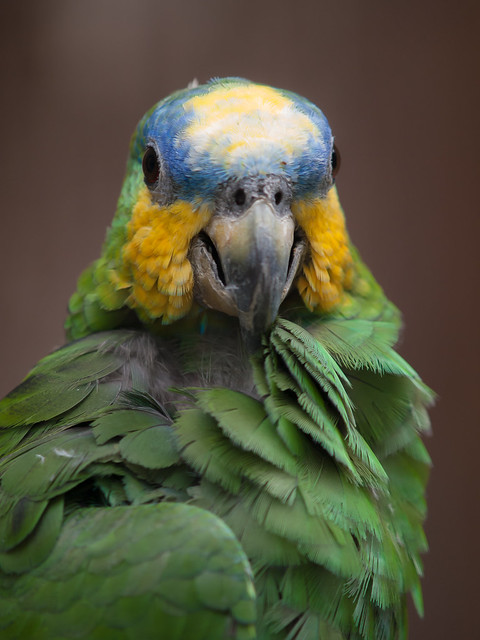 (7) Blue-Fronted Amazon — If you want a companion for life, this is a good fit. The Blue-Fronted can live for up to 100 years, or more. They have an excellent speaking voice, with a strong ability to mimic human voices. The Blue-fronted Amazon (Amazona aestiva), also called the Turquoise-fronted Amazon and Blue-fronted Parrot, is a South American species of Amazon parrot and one of the most common Amazon parrots kept in captivity as a pet or companion parrot. Its common name is derived from the distinctive blue marking on its head just above its beak. The Blue-fronted Amazon is a mainly green parrot about 38 cm (15 in) long. They have blue feathers on the forehead above the beak and yellow on the face and crown. Distribution of blue and yellow varies greatly among individuals. Unlike most other Amazona parrots, its beak is mostly black. There is no overt sexual dimorphism in plumage to the human eye, but analysis of the feathers using spectrometry, a method which allows the plumage to be seen as it would be by a parrot's tetrachromatic vision. Source: http://en.wikipedia.org/wiki/Blue-fronted_amazon 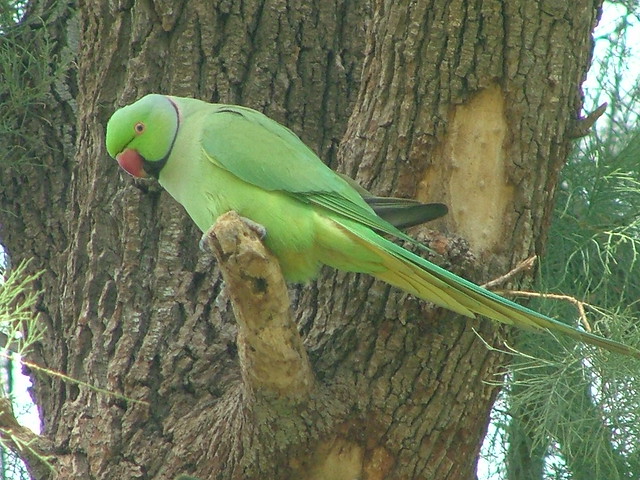 (6) Indian Ringneck — Very clever little birds, Indian Ringnecks (Psittacula krameri), also known as the Ring-necked Parakeet, can develop a large vocabulary, and speak very clearly in sentences. Not so much for mimicking the pitch of a human voice, they more often speak in their own bird voices, though they can carry the mood of the phrase. It is a gregarious tropical Afro-Asian parakeet species that has an extremely large range. Since the trend of the population appears to be increasing, the species was evaluated as Least Concern by International Union for Conservation of Nature in 2012. Rose-ringed parakeets are popular as pets. Its scientific name commemorates the Austrian naturalist Wilhelm Heinrich Kramer.This non-migrating species is one of few parrot species that have successfully adapted to living in 'disturbed habitats', and in that way withstood the onslaught of urbanisation & deforestation. In the wild, this is a noisy species with a sole crying call. Source: Link 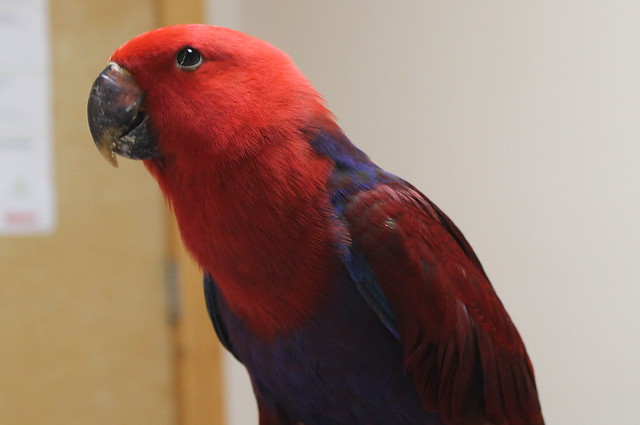 (5) Eclectus —The Eclectus Parrot (Eclectus roratus) is a parrot native to the Solomon Islands, Sumba, New Guinea and nearby islands, northeastern Australia and the Maluku Islands (Moluccas). this parrot is able to verbalize distinctly and mimic the tone and mood of language. While its capabilities are strong, these abilities depend entirely on training from an early age. It is unusual in the parrot family for its extreme sexual dimorphism of the colours of the plumage; the male having a mostly bright emerald green plumage and the female a mostly bright red and purple/blue plumage. Joseph Forshaw, in his book Parrots of the World, noted that the first European ornithologists to see Eclectus Parrots thought they were of two distinct species. Large populations of this parrot remain, and they are sometimes considered pests for eating fruit off trees. Some populations restricted to relatively small islands are comparably rare. Their bright feathers are also used by native tribes people in New Guinea as decorations. The yellow-crowned amazon is found in the Amazon Basin and Guianas, with additional populations in north-western South America and Panama. Source: wikipedia.org/ 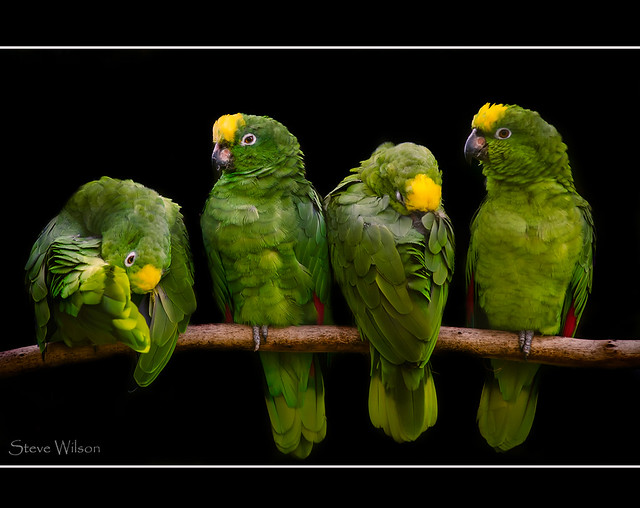 (4) Yellow-Crowned Amazon — Considered to be nearly as good as the Yellow-Naped, with less of a tendency to nip. The Yellow-crowned Amazon or Yellow-crowned Parrot (Amazona ochrocephala), is a species of parrot, native to the tropical South America and Panama. The taxonomy is highly complex, and the Yellow-headed (A. oratrix) and Yellow-naped Amazon (A. auropalliata) are sometimes considered subspecies of the Yellow-crowned Amazon. have a total length of 33–38 cm (13–15 in). As most other Amazon parrots, it has a short squarish tail and a primarily green plumage. It has dark blue tips to the secondaries and primaries, and a red wing speculum, carpal edge (leading edge of the wing at the "shoulder") and base of the outer tail-feathers. The red and dark blue sections are often difficult to see when the bird is perched, while the red base of the outer tail-feathers only infrequently can be seen under normal viewing conditions in the wild. The amount of yellow to the head varies, with nominate, nattereri and panamensis having yellow restricted to the crown-region (occasionally with a few random feathers around the eyes, while the subspeciesxantholaema has most of the head yellow. All have a white eye-ring. They have a dark bill with a large horn or reddish spot on the upper mandible except panamensis, which has a horn coloured beak. Males & females do not differ in plumage. Except for the wing mirror, juveniles have little yellow & red to the plumage. Habitat and distribution: The yellow-crowned amazon is found in the Amazon Basin and Guianas, with additional populations in north-western South America and Panama. It is a bird of tropical forest (both humid and dry), woodland, mangroves, savanna and may also be found on cultivated land and suburban areas. In the southern part of its range, it is rarely found far from the Amazon Rainforest. It is mainly a lowland bird, but has locally been recorded up to 800 m (2600 ft) along on the eastern slopes of the Andes, Source: en.wikipedia.org 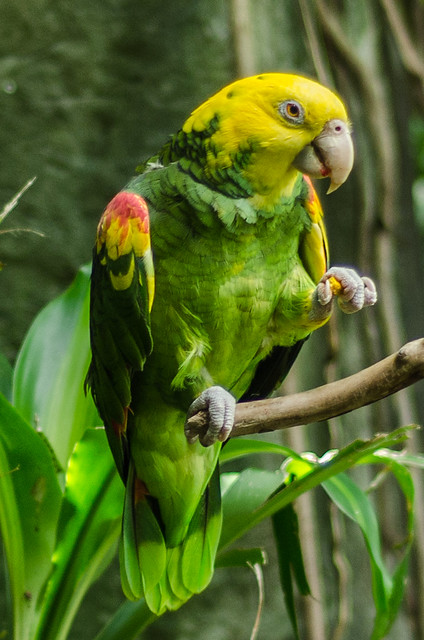 (3) Double Yellow Head Amazon — Closely following the Yellow-Naped, with an excellent ability to mimic human voices and a love for song The Yellow-headed Amazon (Amazona oratrix), also known as the Yellow-headed Parrot and Double Yellow-headed Amazon, is an endangered amazon parrot of Mexico and northern Central America. It prefers to live in mangrove forests or forests near rivers or other bodies of water. It is sometimes considered a subspecies of the Yellow-crowned Amazon. The Yellow-headed Amazon averages 38–43 centimetres (15–17 in) long. The shape is typical of amazons, with a robust build, rounded wings, and a square tail. The body is bright green, with yellow on the head, dark scallops on the neck, red at the bend of the wing, and yellow thighs. The flight feathers are blackish to bluish violet with a red patch on the outer secondaries. The base of the tail also has a red patch, which is usually hidden. The outer tail feathers have yellowish tips. The bill is horn-colored, darker in immatures of the Belizean subspecies. The eye ring is whitish in Mexican birds and grayish in others. The most conspicuous geographical difference is the amount of yellow. In adults, the head and upper chest are yellow in the subspecies of the Tres Marías Islands (tresmariae); just the head in the widespread subspecies of Mexico (oratrix); just the crown in Belize (belizensis); & the crown and nape in the Sula Valley of Honduras (hondurensis, which thus Matches the Yellow-naped Parrot). Immatures have less yellow than adults; join adult plumage in 2 to 4 years. Source: en.wikipedia.org Spotted Wood Kingfisher 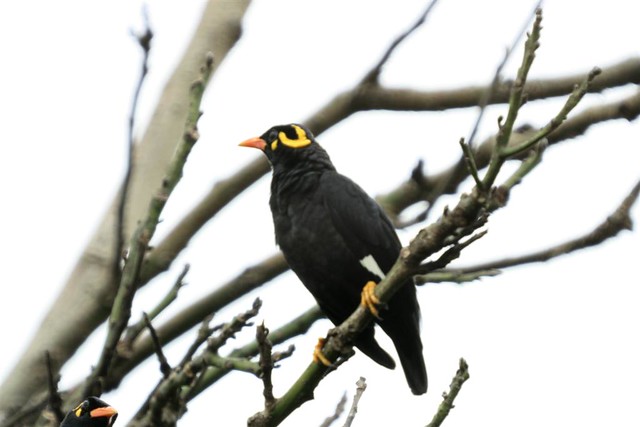
(2) Hill Myna — This pretty little black bird has an amazing capacity for mimicking human voices, with a varied range of pitch and tonality. The common hill myna (Gracula religiosa), sometimes spelled "mynah" and formerly simply known as hill myna, is the myna bird most commonly seen in aviculture, where it is often simply referred to by the latter two names. It is a member of the starling family (Sturnidae), resident in hill regions of South Asia and Southeast Asia. The Sri Lanka hill myna, a former subspecies of G. religiosa, is generally accepted as a separate species G. ptilogenys nowadays. The Enggano hill myna (G. enganensis) and Nias hill myna (G. robusta) are also widely accepted as specifically distinct, and many authors favor treating the southern hill myna (G. r. indica) from the Nilgiris and elsewhere in the Western Ghats of India as a separate species, also. Source: Article
(1) African Grey — The African Grey is widely considered to be the smartest of the talking birds, and one of the most intelligent in the animal kingdom overall. Some experts say they approach the ability to speak and relate concepts on the level of a human toddler. Of the two standard "domesticated" species, the Timneh African Grey tends to learn to speak at a younger age than the Congo African Grey. The African Grey Parrot (Psittacus erithacus), also known as the Grey Parrot, is a parrot found in the primary and secondary rainforest of West and Central Africa. Experts regard it as one of the most intelligent birds in the world. They feed primarily on palm nuts, seeds, fruits, and leafy matter, but have also been observed eating snails. Their overall gentle nature and their inclination and ability to mimic speech have made them popular pets, which has led many to be captured from the wild and sold into the pet trade. The African Grey Parrot is listed on CITES appendix II, which restricts trade of wild-caught species because wild populations cannot sustain trapping for the pet trade. Source: Articl-1-2, Image: 1-2-3-4-5-6-7-8-9-10. Parrot who speaks Urdu & English: Mittu the parrot deserves congratulations – or as the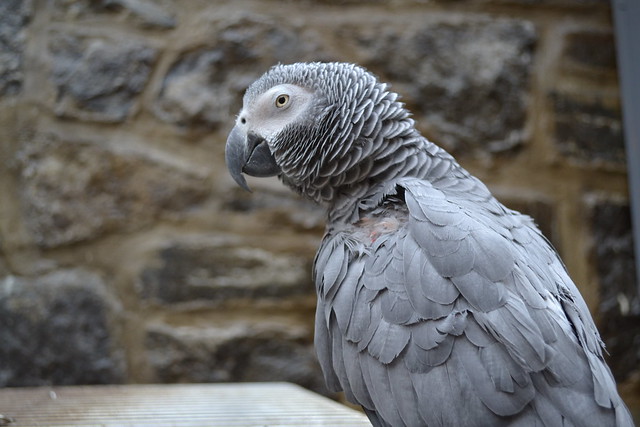  African grey might say, ‘shabaash’, Daily Mail online reports. The bilingual bird has developed an impressive vocabulary in both English and Urdu after being raised in a home where both are spoken.As well as the likes of ‘who’s a pretty boy then’, the two-year-old has mastered the traditional Muslim greeting ‘Asalaam Alaykum’ and ‘Bismillah’, the Urdu for ‘in the name of Allah’. Owner Ghaffar Ahmed, 36, said: ‘He speaks Urdu and English. But he also barks like a dog and makes the noise of the refrigerator alarm, so he likes making all sorts of noises really.’ Mittu lives with Ahmed’s family in Stourbridge, West Midlands. This year a study found that African greys are capable of the same level of intelligent reasoning as a four-year-old child. Ahmed said: ‘I don’t know how many bilingual birds there are in the UK but there can’t be many. ‘My in-laws live in Bradford and a family who they know were looking to re-home the parrot as he was becoming too much of a handful. ‘They wanted him to go to a home that spoke the same language, so we said we’d have him on board and ever since then he has become part of the family. Ahmed, who runs a car firm and accident management company, says he is refusing to take him out to the local mosque – after the parrot escaped recently from his workplace. Ahmed, his wife, Shabana, 31, and their three young daughters were ‘devastated’ when he disappeared. But tears turned to joy when the bird turned up four days later having flown four miles away. Susan Lane, from Halesowen, West Midlands, found the Mittu in her holly tree and found Ahmed online. ‘As soon as we were reunited he came and kissed my face,’ Ahmed added. ‘We were delighted to have him back, it was like losing one of the family when he flew off. ‘So I’m not letting him go out any more, I’m keeping a close eye on him from now on.’ daily times monitor. Source: Article, Image. What is a Mockingbird?: They are members of the Mimidae family, a group of American 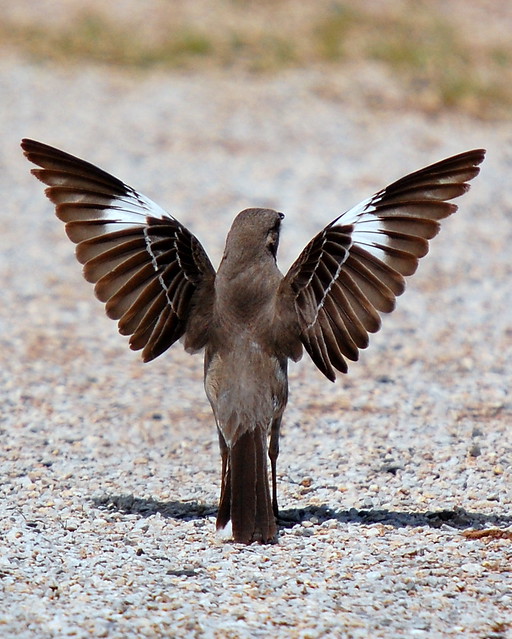
passerines that also includes thrashers, tremblers, and New World catbirds. These stentorian songbirds, medium sized with angular proportions and long, twitchy tails, range from the Canadian border down through South America. The Northern Mockingbird, the most well known representative of this family above the equator, is
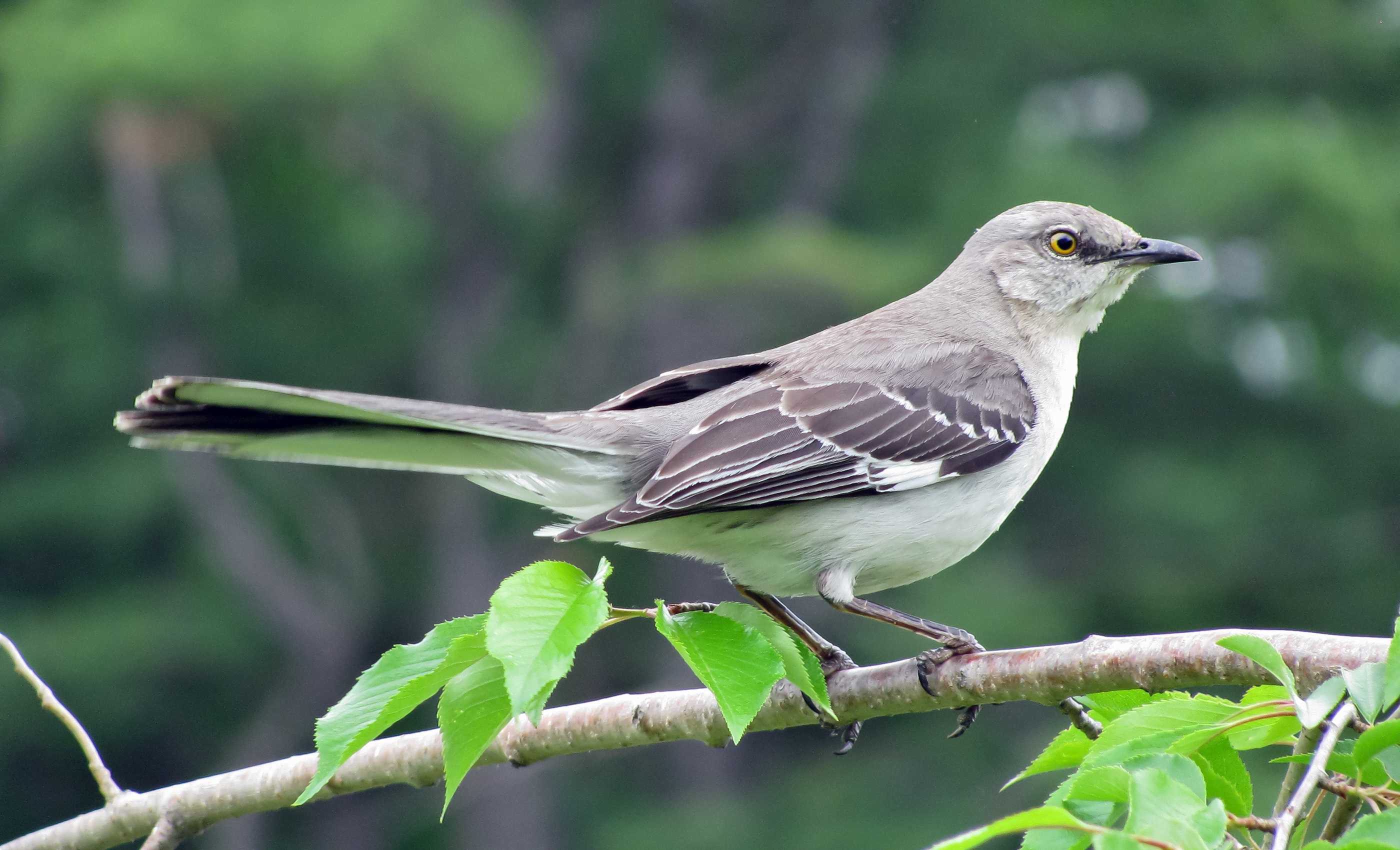
"Mimus polyglottos adult 02 cropped" by Captain-tucker - Own work. Licensed under CC BY-SA 3.0 via Commons.
Northern Mockingbird by Mike, found fittingly at Hotel Mocking Bird Hill in Jamaica
known scientifically as Mimus polyglottos, which comes from the Greek “mimus” to mimic, and “ployglottos” for many-tongued. The song of the mockingbird is actually a medley of the calls of many other birds. Each imitation is repeated two or three times before another song is initiated. A given bird may have 30, 40 or even 200 songs in its

repertoire, including other bird songs, insect and amphibian sounds, and even the occasional mechanical noise. Part of the mockingbird’s advantage over other avians is physical; it uses more of the muscles in its vocal organ, the syrinx, than most other passerines do, many more than non-passerines like raptors or waterfowl. But the mockingbird also has a mind for music. It’s been theorized that this species has more brain matter devoted to song memory than most other birds do. Why does the mockingbird sing? The vocal mimicry trait seems to indicate that lyrical flow is an

"Galapagosmockingbird-santa-fe-island" by Benjamint444 - Own work. Licensed under GFDL 1.2 via Commons.
especially potent aphrodisiac in mockingbird circles, although some lonely males warble and whine the whole night through when unable to find a mate. “Northern” is a rather ambiguous descriptor for Mimus polyglottos, as it is the only mockingbird to appear regularly anywhere north of Mexico. The Northern Mockingbird, clad in shades of gray with conspicuous white wing patches, enjoys exceptional popularity for such a drab specimen, evident in the fact that it is the state bird of Arkansas, Florida, Mississippi, Tennessee and Texas. Other Mimus species mockingbirds, 9 in all, closely resemble the Northern Mockingbird, which, in my experience, is more common in the Bahamas than the Bahama Mockingbird (M. gundlachii) and may even appear in the tropics alongside
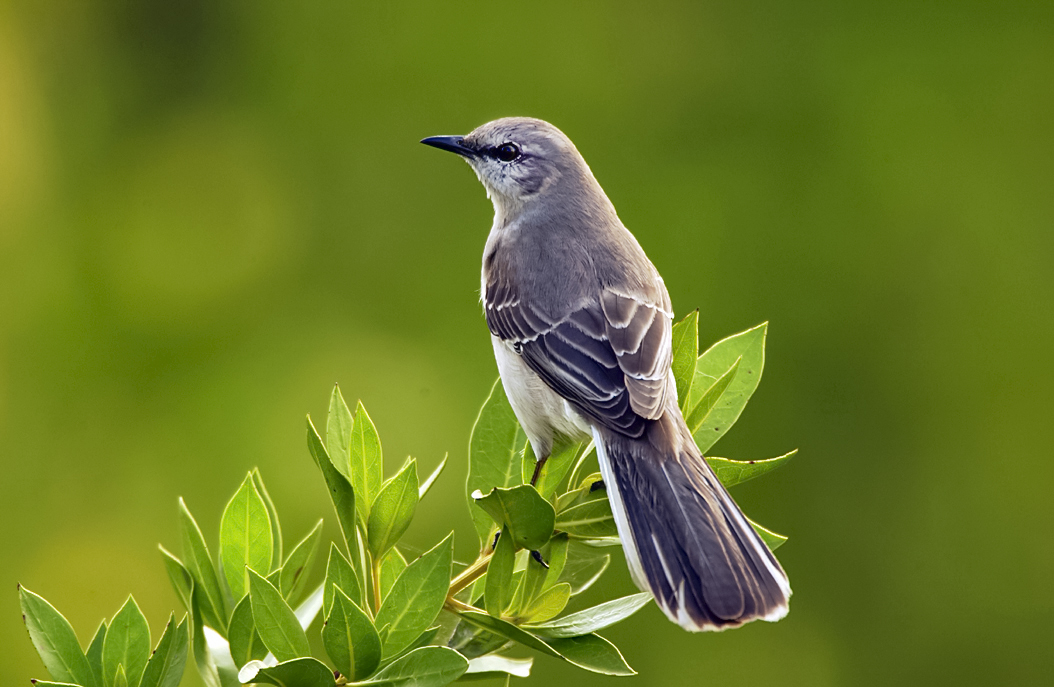
"Mimus polyglottos1" by Ryan Hagerty - This image originates from the National Digital Library of the United States Fish and Wildlife Service This tag does not indicate the copyright status of the attached work. A normal copyright tag is still required. See Commons:Licensing for more information. See Category:Images from the United States Fish and Wildlife Service.. Licensed under Public Domain via Commons.
the Tropical Mockingbird (M. gilvus). No wonder it’s so popular! Birds of the genus Nesomimus are known as the Galapagos mockingbirds. These 4 species endemic to the celebrated archipelago, Galapagos (N. parvulus), Floreana (N. trifasciatus), Espanola (N. macdonaldi), andSan Cristobal (N. melanotis), are said to have been extremely influential in shaping Darwin’s theories on the origins of life. Tragically, the critically endangered Floreana mockingbird is extinct on the island for which it is named. The only Mimodes mockingbird, the Socorro Mockingbird (M. graysoni), endemic to
Socorro Island in the Revillagigedo Islands, is also endangered. Species in the genus Melanotis certainly live up to their billing as the blue mockingbirds. The Blue (M. caerulescens) and Blue-and-white (M. hypoleucus), found in Mexico and Central America, both appear exquisitely azure, a dramatic departure from the family’s typical ashen hues. It’s considered a sin to kill a mockingbird, or at least that’s what we’re told in the book of the same name. Why? As Harper Lee says, “Mockingbirds don’t do one thing but make music for us to enjoy. They don’t eat up people’s gardens, don’t nest in corncribs, they don’t do one thing but sing their hearts out for us. That’s why it’s a sin to kill a mockingbird.” Source: Article. Oh! my feathered friend: People have kept birds as pets for centuries. They have been admired for their companionship and even ornamental value. However, some birds, such as parrots and cockatoos are very intelligent and intuitive as well. When it comes to bringing a bird home, it's important to realise that it requires a commitment that is unparalleled by any other. Exotic birds such as a Cockatoo or Macaw lives up to an age of 50-60 years. Even an ordinary parakeet lives up to 20 years. Exotic birds are the most sought after feathered pets in India. By “exotic” we mean, birds that are not native to India. These include; the African Love Birds, Zebra Finches, Java Sparrows and Budgerigars — commonly known as Lovebirds. Abdul Wahab of the Bengaluru-based Wet Pets, breeds a variety of exotic birds. He says, “Lovebirds are the world’s favourite birds for keeping as pets. Exotic birds arrived in India years ago, brought in by the British, merchants and travellers, from places as far flung as the Amazon, Africa, South America and Australia. Since then they have been bred in captivity in India and have acclimatised to the weather here.” While Cockatoos and Zebra Finches are native to Australia, the Grey Parrot and Yellow Naped Parrot belong to the Amazon. The majestic Macaw comes from South America. “Cockatoos, Macaws and Grey Parrots make great companions, and if brought home as a chick, develops a great bond with the owner.” Sahil Ismail, of the Pune-based Creekwood Birds, has been breeding and keeping birds since the age of ten. Today, Sahil is one of the country’s best known aviculturists with a wide collection of exotic birds. “Keeping birds is relatively easy as they require dry food that comprises of fresh fruit and a mixture of seeds. It is important to constantly supply them with fresh water.” He adds, “In my experience, I’ve found that the African birds are comparatively fragile, while the South African ones are hardy.” Anna Verghese, who’s kept a number of birds as pets at home, comments, “Birds are certainly not as demanding as dogs or cats. They require their nails to be trimmed regularly — so that they don’t scratch us. Also, their feathers need to be clipped as they can’t survive in the wild.” Source: Article. Birds That Live With Varying Weather Sing More Versatile Songs: A new study of
Credit: Wikipedia
North American songbirds reveals that birds that live with fluctuating weather are more flexible singers. Mixing it up helps birds ensure that their songs are heard no matter what the habitat, say researchers at Australian National University and the National Evolutionary Synthesis Center. To test the idea, the researchers analyzed song recordings from more than 400 male birds spanning 44 species of North American songbirds — a data set that included orioles, blackbirds, warblers, sparrows, cardinals, finches, chickadees and thrushes. They used computer software to convert each sound recording — a medley of whistles, warbles, cheeps, chirps, trills and twitters — into a spectrogram, or sound graph. Like a musical score, the complex pattern of lines and streaks in a spectrogram enable scientists to see and visually analyze each snippet of sound. For each bird in their data set, they measured song characteristics such as length, highest and lowest notes, number of notes, and the spacing between them. When they combined this data with temperature and precipitation records and other information such as habitat and latitude, they found a surprising pattern — males that experience more dramatic seasonal swings between wet and dry sing more variable songs. "They may sing certain notes really low, or really high, or they may adjust the loudness or tempo," said co-author Clinton Francis of the National Evolutionary Synthesis Center. The Pyrrhuloxia or desert cardinal from the American southwest and northern Mexico and Lawrence's goldfinch from California are two examples. In addition to variation in weather across the seasons, the researchers also looked at geographic variation and found a similar pattern. Namely, species that experience more extreme differences in precipitation from one location to the next across their range sing more complex tunes. House finches and plumbeous vireos are two examples, Francis said. Why might this be? "Precipitation is closely related to how densely vegetated the habitat is," said co-author Iliana Medina of Australian National University. Changing vegetation means changing acoustic conditions. "Sound transmits differently through different vegetation types," Francis explained. "Often when birds arrive at their breeding grounds in the spring, for example, there are hardly any leaves on the trees. Over the course of just a couple of weeks, the sound transmission changes drastically as the leaves come in." "Birds that have more flexibility in their songs may be better able to cope with the different acoustic environments they experience throughout the year," Medina added. A separate team reported similar links between environment and birdsong in mockingbirds in 2009, but this is the first study to show that the pattern holds up across dozens of species. Interestingly, Francis and Medina found that species with striking color differences between males and females also sing more variable songs, which means that environmental variation isn't the only factor, the researchers say. The team's findings were published online in the August 1, 2012 issue of the journal Biology Letters. Contacts and sources: Robin Ann Smith, National Evolutionary Synthesis Center (NESCent), Citation: Medina, I. and C. Francis (2012). "Environmental variability and acoustic signals: a multilevel approach in songbirds." Biology Letters. http://dx.doi.org/10.1098/rsbl.2012.0522, The National Evolutionary Synthesis Center (NESCent) is a nonprofit science center dedicated to cross-disciplinary research in evolution. Funded by the National Science Foundation, NESCent is jointly operated by Duke University, The University of North Carolina at Chapel Hill, and North Carolina State University. For more information about research and training opportunities at NESCent, visit www.nescent.org. Source: Nano Patents And Innovations, Animals Know What They Are Talking About: African Grey Parrot Has Social Skills of 2 Year Old and
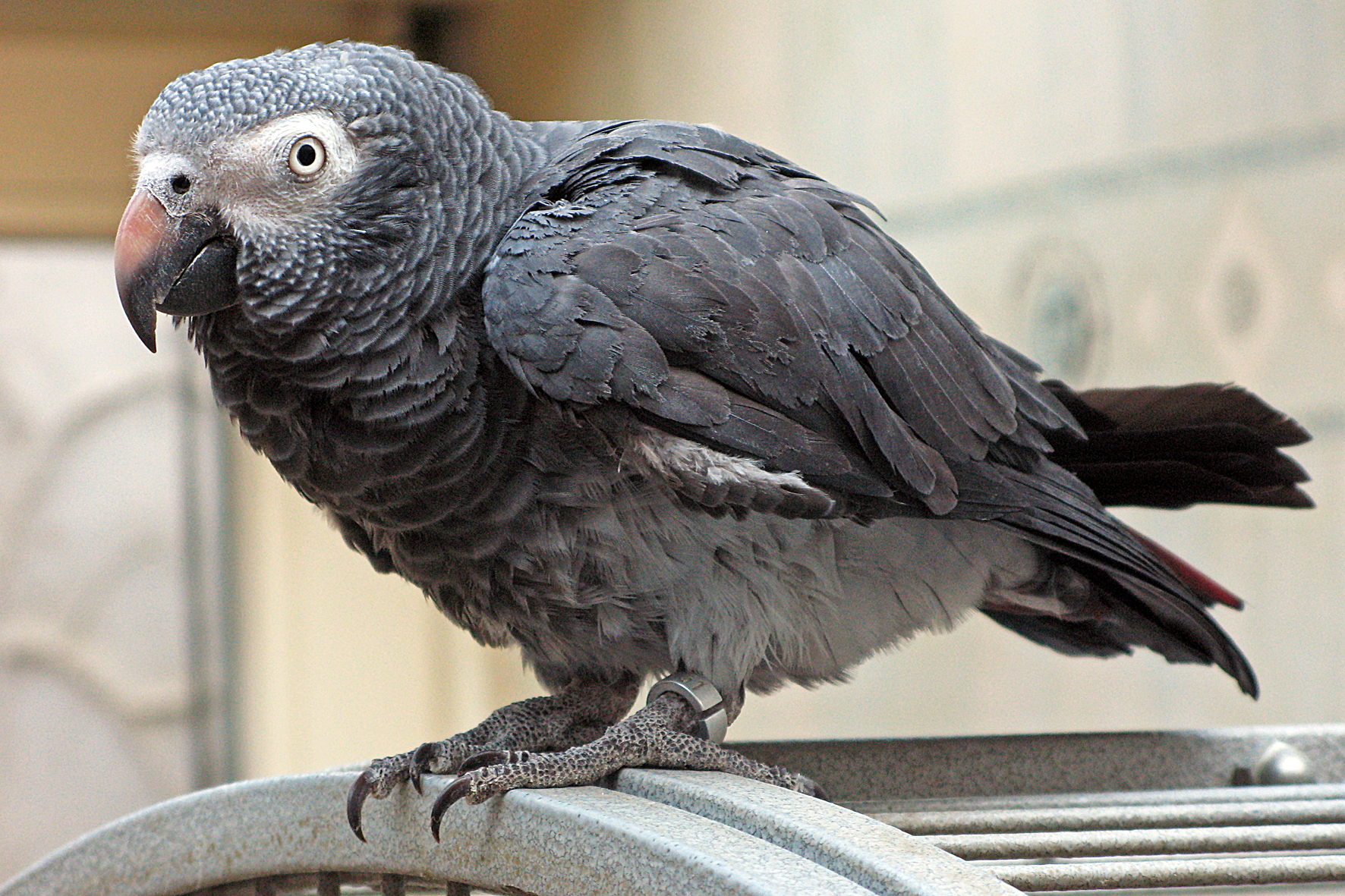
"Psittacus erithacus timneh-parrot on cage" by Peter Fuchs - Flickr. Licensed under CC BY-SA 2.0 via Commons.
Intelligence of 5 Year Old Child: These bird brains are proving to be smarter than we thought When African Grey parrots talk, do they mimic sounds or consciously understand their speech? Irene Pepperberg, a comparative psychologist at both Brandeis and Harvard universities believes African Greys actually know what they’re talking about. "They understand things like categories of color, material and shape, number concepts, and concepts of bigger and smaller, concepts of similarity and difference, and absence; things we once thought that a bird could not comprehend, these parrots are showing us it's possible," says Pepperberg. With support from the National Science Foundation (NSF), Pepperberg studies the cognitive and communicative abilities of African Greys. She says the birds have the social skills of a 2-year-old child and the intelligence of a 5-year-old. That statement might ruffle some feathers, but in Pepperberg's lab at Brandeis University in Waltham, Mass., she's out to prove that talking with the animals isn't just the stuff of fiction. To start, talking with these birds means simplifying language down to "motherese." Instead of asking what something is made of, Pepperberg will ask, "What matter?" And, when she asks the bird "What shape?" instead of saying "square," they say "four-corner," to clarify the relationship between shape and numbers of points on an object. One of the things Pepperberg studies is the parrots' ability to identify partially obscured shapes. "In the wild, we expect these birds to be able to do that because if you see part of a predator, you want to respond as if it is an entire predator," says Pepperberg. She demonstrates this by showing a parrot a square, partially obscured by a circle, and the bird is still able to identify the shape as "four-corner." If the parrot responds to "What shape?" by just saying "corner," Pepperberg asks "How many corners?" and the parrot responds "four." The bird doesn't get it right 100 percent of the time, but Pepperberg's data suggests they understand the concept of a square even when it is partially obscured. When testing, Pepperberg is cautious, making sure she doesn't send subtle cues to the birds. "We have controlled for that many times," she explains. "We have different people training versus testing. We mix up different types of questions in each test session. The testing is basically blind." Pepperberg says her research on talking with birds has benefits for humans. "A colleague has used our training techniques--a two-person modeling system--with autistic children to help them learn speech and communication skills," she says. Pepperberg believes that despite the birds having a brain the size of a shelled walnut, their contribution to understanding language and intelligence is significant. "All of our work is trying to show people that 'birdbrain' should really be a compliment," she adds. Contacts and sources: National Science Foundation, Miles O'Brien, Science Nation Correspondent, Jon Baime, Science Nation Producer. Source: Article, Image
Aggressive
 In any case, the image of a bird generally doesn’t produce anything terrifying. However, not all birds are cute, and not all of them are nice, so to speak. There are hundreds of birds that could attack a human, and do a lot of damage. Here is a list of nine most dangerous bird. 1. Cassowaries Cassowaries, an endangered species, are  large, flightless birds that live in the rainforests, woodlands and swamps of Australia. Cassowaries are unpredictable, aggressive and are known to kick up their large, clawed feet. Their kicks are capable of breaking bones, and their claws have been likened to daggers. 2. Ostriches: Ostriches are suspicious, skittish and can be dangerous.  They're the largest living bird (they can reach over 9 feet tall and 350 pounds) and they can outrun you (a steady 30 miles an hour for 10 miles straight). Like the cassowary, they have strong legs (their kick can kill a hyena) and sharp claws. 3. Canada Geese: Canada geese are very aggressive and, particularly if you (purposely  or inadvertently) come near their nests or young, they may chase you away and even bite you. 4. Seagulls: Seagulls are extremely aggressive and are known to attack and even peck at people's heads to protect their nests and young. In fact, in Britain people have been forced to carry umbrellas to avoid the attacks, at least one  woman was taken to an emergency room with deep beak wounds to her head, and a pet dog was killed by the birds. 5. Owls: Owls are raptors, or birds of prey, and they use their talons and beaks to kill and eat their catch. In a closed space, or if the bird  was scared or agitated, it could cause serious harm to you. 6. Hawks and Falcons: Also birds of prey, the sharp talons and beaks that hawks and falcons use to hunt, along with their quick speed and agility, pose serious dangers to humans, even if  the birds are just babies (falcons' beaks are also specially configured to cut through the spinal cords of their prey). 7. Eagles: Eagles are strong (strong enough to carry away something that weighs four pounds), aggressive birds, and although they don't pose  much of a danger to humans in the wild, in a closed space their beak and talons could easily harm a human. (FYI, they can eat about a pound of fish in just four minutes.) 8. Vultures: If cornered, a vulture (many species of which are now endangered) may  hiss or make a low grunting sound at you. They, of course, also have sharp, hooked beaks that can tear meat, along with excellent eyesight. 9. Rheas: The rhea, native to South America, is a large, flightless bird that can grow to be 60-80 pounds. Though  smaller than ostriches and not as aggressive as cassowaries, rheas have heavily muscled legs, hard spurs on their feet and their kicks can bring a force of 800 pounds per square inch. Source: Article. Golden Eagle tries to snatch kid in 
Golden Eagle is moving towards kids (Image: Screen shot on below video)
Montreal: A child flees from what could have been a disaster, as he is clutched by a Golden Eagle, while sitting in a park in Montreal, Canada. You can observe as the eagle moves towards the baby, and the father is filming the whole event. As he perceives the bird start to veer down, and skull it for his people, he frights and jogs towards it. The infant is raised in the air for a few moments, but it emerges the eagle lets go soon after. Many are claiming this video is a fake, as the father's reaction seems to be too detached and a little late. After all, he stops to admire the bird instead of running to protect his family as he sees it approach them. If you didn't catch the sequence, it is
played in small motion at the end of the clip. According to wikipedia The Golden Eagle (Aquila chrysaetos) is one of the best-known birds of prey in the Northern Hemisphere. It is the most widely distributed species of eagle. Like all eagles, it belongs to the family Accipitridae. Once widespread across the Holarctic, it has disappeared from many areas which are now more heavily populated by humans. Despite being extirpated from or uncommon in some its former range, the species is still fairly ubiquitous, being present in sizeable stretches of Eurasia, North America, 
and parts of North Africa. It is largest and least populous of the mere 5e species of true accipitrid to occur as a breeding species in both the Palearctic and the Nearctic, alongside the Osprey (Pandion haliaetus), the Hen Harrier (Circus cyaneus), the Northern Goshawk (Accipiter gentilis) and the Rough-legged Buzzard (Buteo lagopus). The Golden Eagle is one of the most extensively studied species of raptor in the world in some parts of its range, such as the Western United States and the Western Palearctic (especially Scotland,Scandinavia and Spain). However in many other parts of its range, especially in Asia (outside of Japan) and Russia, the life histories of Golden Eagles are mostly unknown. In the Middle East, the Caucasus, North Africa and even the Eastern United States and Eastern Canada, they are relatively poorly known, though the number of studies in these areas have recently increased. These birds are dark brown, with lighter golden-brown plumage on their napes. Immature eagles of this species typically have white on the tail and often have white markings on the wings. Golden Eagles use their agility and speed combined with extremely powerful feet and massive, sharp talons to snatch up a variety of prey. The most prevalent prey are hares, rabbits, marmots and other ground

squirrels. Exceptionally large, such as foxes and young ungulates, and small mammals, such as shrews and mice, can turn up in the diet as well. Birds, including large species up to the size of swans and cranes, have also been recorded as prey. Certainly, the preferred avian prey would be the galliforms. They will occasionally eat carrion, as well as reptiles, amphibians and even insects. For centuries, this species has been one of the most highly regarded birds used in falconry, with the Eurasian subspecies having been used to hunt and kill unnatural, dangerous prey such as Gray Wolves (Canis lupus) in some native communities. Due to their hunting prowess, the Golden Eagle is regarded with great mystic reverence in some ancient, tribal cultures. Unfortunately, the same boldness and power that led to them being held with reverence in early cultures has led to wholesale persecution in the last few centuries, due to the perceived (and often greatly exaggerated) threat Golden Eagles pose to domestic and game stock. Golden Eagles maintain home ranges or territories that may be as large as 200

"Eagle and Lamb - James Audubon" by James Audubon - http://ia351434.us.archive.org. Licensed under Public Domain via Commons.

also have their iconic symbols that can range from buildings to geological formations to plants and animals. For the United States, it is the bald eagle - a symbol of magnificence and strength. And as the American expansion rolled across the great nation, the bald eagle, whether deliberately or by accident, was slowly pressured and pushed from one habitat to another until this iconic symbol of one of the most powerful and successful nations on earth was faced with extinction. Irony abounds. Chosen as the national bird in 1782 (to the disappointment of statesman Benjamin Franklin who had proposed the turkey), the bald eagle's numbers slowly declined until there were only 417 nesting pairs of eagles in the lower 48 states when the Endangered Species Act was initiated in 1963 (the bald eagle was formally declared endangered under the Act in 1967). The nation's founding fathers did not have to travel far within the new fledgling states to see a bald eagle, but by the 20th century the birds were typically found only in rugged, remote mountainous areas - further west and north where human populations were scarce as was large scale agriculture. Along with large commercial agriculture came the need to control pests and with that came the use of pesticides. The broad use of DDT contributed to the decline of the bald eagle - as well as many other birds of prey - as the pesticide slowly worked its way
up the food chain. When ingested by bald eagles, it produced weakened eggs and the bird's survival rate plummeted. Midwest states, with large population centers and agriculture, were essentially devoid of bald eagles. The state of Iowa, as an example, did not have a single nest from the early 1900s until the late 70s when one nest was finally sighted. But now it appears that is all changing. Iowa's number of nesting pairs numbered around 9,000 in 2006 and they continue to grow. With the use of DDT discontinued, along with the adoption of other regulatory measures between the United States and Canada, the overall population of bald eagles has continued to rise and it was officially de-listed under the Endangered Species Act in 1997. Numbers now range over 115,000 in the United States and Canada. The Iowa Department of Natural Resources carefully monitors the number of nests and nesting pairs, utilizing a program that involves both government officials and volunteers to monitor the nests. The birds need to be observed but not disturbed in any way, so involved conservation groups and the department keep the exact location of many of the nests under wraps. The return of bald eagles to states like Iowa is an example of the overall success nationwide in bringing back the populations of bald eagles back to respectable levels. It is the iconic symbol of a nation but, more importantly, it is an important member of nature's balanced community and a success story that bears repeating for many animal and plant species from coast to coast. The Republic, Source: Wikipedia, Article, Scientists Show Dinosaur Body Shape Changed The Way
Credit: University of Liverpool
Birds Stand: Scientists at the University of Liverpool and the Royal Veterinary College developed computer models of the skeletons of dinosaurs to show how body shape changed during dinosaur evolution and affected the way birds stand today. The study reveals for the first time that, contrary to popular opinion, it was the enlargement of the forelimbs over time, rather than the shortening and lightening of the tail, that led to two-legged dinosaurs gradually adopting an unusually crouched posture, with the thigh held nearly horizontally – a trait inherited by their descendants: birds. The research group used digitising technology to create 3D images of the skeletons of 17 archosaurs – land animals including living crocodiles and birds as well as extinct dinosaurs. They then digitally added ‘flesh’ around the skeletons to estimate the overall shape of the body as well as the individual body segments such as the head, forelimbs and tail. Evolution: Dr Karl Bates, from the University’s Institute of Ageing and Chronic Disease, said: “The evolution of birds from their dinosaurian ancestors is historically important not only to dinosaur research but also to the development of the theory of evolution itself. “Way back in the 1860’s, Thomas Huxley used Mesozoic dinosaurs and modern birds as key evidence in promoting Darwin’s theory of evolution. In this study, modern digital technologies have allowed us to quantify the ‘descent with modification’ observed by Huxley all those years ago. “This quantifiable evidence, derived from fossils, helps make evolution more apparent to a general audience, and helps demonstrate exactly how scientists understand what they do know about evolution.” Dr Vivian Allen, from the Royal Veterinary College, said: “We started from a simple digital ‘shrink-wrap’ of the whole skeleton. From this, we expanded the ‘shrink-wrap’ to match how much flesh we think existed around the different parts of the skeleton. This was based on both detailed reconstruction of the muscular anatomy of each animal, and on what we have measured from CT scans of their living relatives.” Prior research had shown that the first archosaurs, around 245 million years ago, were superficially like modern crocodiles – four-legged animals with long, heavy tails, although with longer limbs for living and moving on land. However, early in the evolution of the dinosaur lineage, about 235 million years ago, dinosaurs became bipedal, a trait inherited by their descendants – birds. Birds stand and walk in an unusually crouched posture, with the thigh held nearly horizontally. Palaeontologists had agreed for years that this strange way of moving evolved gradually as the tail became shorter, shifting the centre of mass of certain dinosaurs progressively forward as those dinosaurs became more “bird-like”, and thereby requiring the legs to become less vertical and more crouched to keep the centre of mass balanced over the feet. A major, unexpected implication of the team’s discovery is that, due to the effects on centre of mass position on leg posture, forelimb size and leg function are biomechanically linked. So, these changes in the forelimb anatomy of dinosaurs, both before and after flight, also altered the way they stood, walked and ran. The study was supported by funds from the Natural Environment Research Council and the Royal Society. Contacts and sources: University of Liverpool, Source: Article. Red-Tailed Hawk: predatory birds are ever-present & vital to nature's balance: Predators play an important role in maintaining balance within nature's ecosystems. When we think of a predator, we often think of large animals like sharks, lions, or wolves. But predators come in all sizes. In  fact, any animal that feeds on another animal can be considered a predator and that predation helps to keep the populations of its prey healthy by weeding out the sick or aged, and keeping numbers in check by counteracting high reproductive rates. In fact, for animals that are prey to several different kinds of predators, a high reproductive rate is nature's consolation prize of sorts for being the unwitting prize of a predator. In the seas, plankton, krill and many species of small bait-fish have high reproductive rates as they are a food source for many different predator species ranging from small reef fish to massive whales. And on land, many rodent species - rats and mice in particular - reproduce in great numbers to offset predation from everything from coyotes to hawks. Speaking of predatory birds, their roles are very similar to predators like sharks. Two roles actually, depending on the bird. Sharks play a critical role as scavengers and there are vultures and buzzards that play a similar role. Sharks are also hunters and hawks and eagles follow parallel duties. To hunt, the predator needs an advantage and for hawks it can often be incredibly sharp eyesight combined with lightning speed. Source: Article. Hawks, eagles, attack US Army's new realistic robotic bird drone: Washington: A robotic bird created for the US fact, any animal that feeds on another animal can be considered a predator and that predation helps to keep the populations of its prey healthy by weeding out the sick or aged, and keeping numbers in check by counteracting high reproductive rates. In fact, for animals that are prey to several different kinds of predators, a high reproductive rate is nature's consolation prize of sorts for being the unwitting prize of a predator. In the seas, plankton, krill and many species of small bait-fish have high reproductive rates as they are a food source for many different predator species ranging from small reef fish to massive whales. And on land, many rodent species - rats and mice in particular - reproduce in great numbers to offset predation from everything from coyotes to hawks. Speaking of predatory birds, their roles are very similar to predators like sharks. Two roles actually, depending on the bird. Sharks play a critical role as scavengers and there are vultures and buzzards that play a similar role. Sharks are also hunters and hawks and eagles follow parallel duties. To hunt, the predator needs an advantage and for hawks it can often be incredibly sharp eyesight combined with lightning speed. Source: Article. Hawks, eagles, attack US Army's new realistic robotic bird drone: Washington: A robotic bird created for the USArmy for being used as a miniature spy drone is so convincing that it has been attacked by hawks and eagles, according to researchers. The solar-powered, remotely piloted surveillance aircraft, called Robo-Raven, was designed and built at the University of Maryland's Maryland Robotics Center, reports the Washington Times. John Gerdes, a mechanical engineer with the Vehicle Technology Directorate at the US Army's Aberdeen Proving Ground in Maryland, said that the Robo-Raven already attracts attention from birds in the area which tends to hide its presence. Seagulls, songbirds and sometimes crows tend to try to fly in formation with the robotic bird during testing, but birds of prey, such as falcons and hawks, take a much more aggressive approach, he said. The Robo-Raven's wings flap completely independently of each other and can be programmed to perform any desired motion, enabling the bird to carry out aerobatic flight maneuvers, such as diving and rolling, never before possible, Gerdes said. (ANI). Source: Article.
Speed
Hickman Students use a special high-speed camera to discover new, never-before-seen intricacies of flight and slow motion video to analyze flight parameters for future applications. "The best way to prevent a small drone from spying on you in your office is to turn on the air-conditioning," said David Lentink, an assistant professor of mechanical engineering at Stanford. That little blast of air, he explained, creates enough turbulence to knock a hand-size UAV off balance, and possibly send it crashing to the floor. A pigeon, on the other hand, can swoop down busy city streets, navigate around pedestrians, sign posts and other birds, keep its path in all sorts of windy conditions, and deftly land on the tiniest of hard-to-reach perches. Graduate student Eirik Ravnan works with a parrotlet that he is training to fly from perch to perch in order to be filmed by a high-speed camera. "Wouldn't it be remarkable if a robot could do that?" Lentink wondered. If robots are to become a bigger presence in urban environments, they will need to. In order to build a robot that can fly as nimbly as a bird, Lentink began looking to nature. Using an ultra-high-speed Phantom camera that can shoot upwards of 3,300 frames per second at full resolution, and an amazing 650,000 at a tiny resolution, Lentink can visualize the biomechanical wonders of bird flight on an incredibly fine scale. Anna's hummingbirds, often spotted darting from flower to flower on the Stanford campus, beat their wings about 50 times per second, nothing but a green blur to human eyes. "Our camera shoots 100 times faster than humans' vision refresh rate," Lentink said. "We can spread a single wing beat across 40 frames, and see incredible things." First flight Every time Lentink's students take the camera into the field, they have the potential to make a groundbreaking discovery. Thousands of birds have never been filmed with a high-speed camera, their secret flight mechanics never exposed. Students Andreas Peña Doll and Rivers Ingersoll filmed hummingbirds performing a never-before-seen "shaking" behavior: As the bird dived off a branch, it wiggled and twisted its body along its spine, the same way a wet dog would try to dry off. At 55 times per second, hummingbirds have the fastest body shake among vertebrates on the planet – almost twice as fast as a mouse. The shake lasted only a fraction of a second, and would never have been seen without the aid of the high-speed video. "We're actually in a position where we can quantitatively analyze this video, and some of the results are the first results of their kind," said Ingersoll, an engineering graduate student who specializes in hummingbird flight. "It is kind of cool to know that potentially other researchers in the future will look at the data we've got in this class and [it will] help them with their research." Though Lentink's lab has amassed hours of short clips of bird flight, it's difficult to frame up a perfect shot in the wild, so his students supplement this footage with carefully orchestrated laboratory-based experiments. "In the field, you can observe social interactions near other birds, how they fly through the wind or through clutter," Lentink said. "This is very valuable. But the conditions aren't always ideal for examining discrete motions." Eirik Ravnan, a mechanical engineering graduate student, trains small birds called parrotlets to fly from perch to perch, or to fly through narrow passageways. In exchange for their flight displays, the birds receive their favorite seeds as a reward. Repeating and videotaping these actions in controlled conditions, he said, makes it possible to look more carefully at, for example, exactly how a bird tilts its wings to slow itself when landing, or how birds corner. The lab just acquired an advanced flow measurement system that can help elucidate how the birds manipulate the airflow with their wings during such maneuvers. "I've never even had a pet," Ravnan said. "But working with birds and investigating their flight mechanics and thinking about how to apply those abilities to robots has been a really interesting way to apply my studies in fluid dynamics." A better bird 'bot Search-and-rescue is one of the more attractive applications for robotic planes, particularly scanning a wide urban area for survivors after a natural disaster. The unpredictable environment will demand robots that can better deal with changing conditions. Mini-copters and planes often stall at steep angles, or when they get caught in a gust of wind. They have difficulty avoiding other airborne objects, and fly clumsily near buildings. Lentink and his students have already begun applying the lessons they've learned from birds to various robotic designs. "Hummingbirds are amazing at hovering, but it's not a very efficient form of flight," said Waylon Chen, a graduate student in Lentink's lab. "A swift flies a lot, so it has a very efficient wing platform, but its legs are too short to land. As we lay out the goal of our robotic design, we can pick and choose which natural mechanisms will be useful, and incorporate only those." This summer Lentink is making his camera and students available to local birders. (To apply, fill out this questionnaire. Email questions to birderquestionnaire@gmail.com) "We'd like to pair the camera with some bird enthusiasts who might know the natural history of these birds better than us," Lentink said. "We want to give people outside of Stanford the magical experience of using this camera, and hopefully learn something more about birds in the process." Contacts and sources: By Bjorn Carey, David Lentink, Mechanical Engineering, Dan Stober, Photo: L.A. Cicero, Stanford News Service, Source: Nano-Patents And Innovations. Pigeons use mental map to
 
"Canada-Goose-Szmurlo". Licensed under CC BY 2.5 via Commons.
of the world but some of are better then all. Spine Tailed Swift: The White-throated Needletail (Hirundapus caudacutus), also known as Needle-tailed Swift or Spine-tailed Swift, is a large swift. It is the fastest-flying bird in flapping flight, with a confirmed maximum of 111.6 km/h (69.3 mph). It is commonly reputed to reach velocities of up to 170 km/h (105 mph), though this has not been verified. These birds have very short legs which they use only for clinging to vertical surfaces. They build their nests in rock crevices in cliffs or hollow trees. They never settle voluntarily on the ground[citation needed] and spend most of their lives in the air, living on the insects they catch in their beaks. These swifts breed in rocky hills in central Asia and southern Siberia. This species is migratory, wintering south in the Indian Subcontinent, Southeast Asia and Australia. It is a rare vagrant in western Europe, but has been recorded as far west as Norway, Sweden and Great Britain. In June 2013, the bird was spotted in the United Kingdom, the first sighting in 22 years. The bird flew into a wind turbine and died; its body was sent to a museum. The White-throated Needletail is a mid sized bird, similar in size to Alpine Swift, but a different build, with a heavier barrel-like body. They are black except for a white throat, white undertail, which extends on to the flanks, and a somewhat paler brown back. The Hirundapus needletailed swifts get their name from the spiny end to the tail, which is not forked as in the Apus typical swifts. Source: Article. Frigate Bird: It is commonly reputed to reach velocities of up

"Fregata magnificens -Galapagos, Ecuador -male-8 (1)" by Andrew Turner from Washington, DC, United States - Frigate Bird Uploaded by
to 153 km/h , They are found mostly in North American and Central American countries. The frigatebirds are a family, Fregatidae, of seabirds. There are five species in the single genus Fregata. They are also sometimes called Man of War birds or Pirate birds. Since they are related to the pelicans, the term "frigate pelican" is also a name applied to them. They have long wings, tails, and bills and the males have a red gular pouch that is inflated during the breeding season to attract a mate. Frigatebirds are pelagic piscivores that obtain most of their food on the wing. A small amount of their diet is obtained by robbing other seabirds, a behaviour that has given the family its name, and by snatching seabird chicks. Frigatebirds are seasonally monogamous, and nest colonially. A rough nest is constructed in low trees or on the ground on remote islands. A single is laid each breeding season. The duration of parental care in frigatebirds is the longest of any bird. [citation needed]. Spur Winged Goose: It is commonly reputed to reach velocities of up to 142 km/h ,
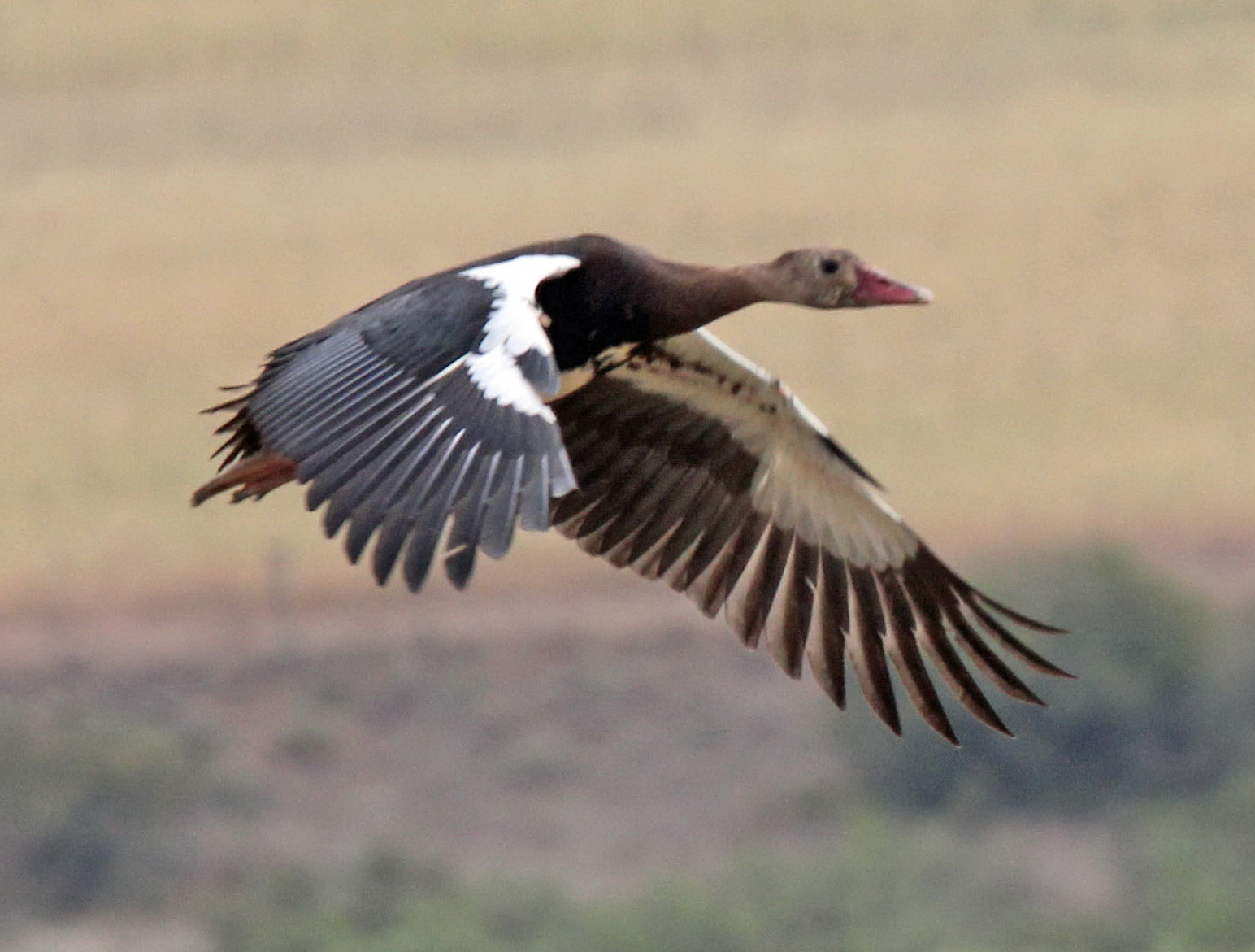
"Spur-winged Goose RWD4" by Dick Daniels (http://carolinabirds.org/) - Own work. Licensed under CC BY-SA 3.0 via Commons.
Spur Winged Goose is the worlds third fastest flying bird. It can fly 142 kilometers per hour. The Spur-winged Goose (Plectropterus gambensis) is a large bird in the family Anatidae, related to the geese and the shelducks, but distinct from both of these in a number of anatomical features, and therefore treated in its own subfamily, the Plectropterinae. It occurs in wetlands throughout sub-Saharan Africa.Adults are 75–115 cm (30–45 in) long and weigh on average 4–6.8 kg (8.8–15 lb), rarely up to 10 kg (22 lb), with males noticeably larger than the females. The wingspan can range from 150 to 200 cm (59 to 79 in). On average, the weight of males is around 6 kg (13 lb) and the weight of females is around 4.7 kg (10 lb). Among standard measurements, the wing chord is 42.5 to 55 cm (16.7 to 22 in), the bill is 5.7 to 6.4 cm (2.2 to 2.5 in) and the tarsus is 5.7 to 12 cm (2.2 to 4.7 in). They are the largest African waterfowl and are, on average, the world's largest wild "goose". They are mainly black, with a white face and large white wing patches. The long legs are flesh-coloured. The nominate race P. g. gambensis has extensive white on the belly and flanks, but the smaller-bodied subspecies P. g. niger, which occurs south of the Zambezi River, has only a small white belly patch. From a distance, P. g. niger can appear to be all black. The male differs from the female, not only in size, but also in having a larger red facial patch extending back from the red bill, and a knob at the base of the upper mandible. This is generally a quiet species. Typically, only males make a call, which consists of a soft bubbling cherwit when taking wing or alarmed. During breeding displays or in instances of alarm, both sexes may utter other inconspicuous calls Source: Article. Red-Breasted Merganser: It is commonly reputed to reach velocities of up to 142 km/h, The adult
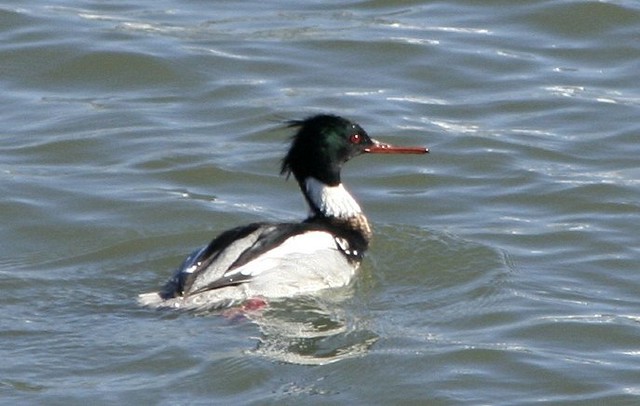
Red-breasted Merganser is 51–62 cm (20–24 in) long with a 70–86 cm (28–34 in). It has a spiky crest and long thin red bill with serrated edges. The male has a dark head with a green sheen, a white neck with a rusty breast, a black back, and white underparts. Adult females have a rusty head and a greyish body. The juvenile is like the female, but lacks the white collar and has a smaller white wing patch. Source: Article. White Rumped Swift: It is commonly reputed to reach velocities of up to
"Juvenile White-bellied Sea-eagle" by JJ Harrison (jjharrison89@facebook.com) - Own work. Licensed under CC BY-SA 3.0 via Commons.
129 km/h, The White-rumped Swift (Apus caffer) is a small swift. Although this bird is superficially similar to a House Martin, it is not closely related to that passerine species. The resemblances between the swallows and swifts are due to convergent evolution reflecting similar life styles. Swifts have very short legs that they use only for clinging to vertical surfaces. They never settle voluntarily on the ground, and spend most of their lives in the air, feeding on insects that they catch in their beaks. They drink on the wing. White-rumped Swifts breed in much of sub-Saharan Africa, and have expanded into Morocco and southern Spain. The populations in Spain, Morocco and the south of Africa are migratory, although their wintering grounds are not definitively known. Birds in tropical Africa are resident apart from seasonal movements. This species appropriates the nests of little swifts and those swallows which build retort-shaped nests. In Europe and north Africa, this usually means the Red-rumped Swallow, but south of the Sahara other species like Wire-tailed Swallow are also parasitised. The original owners of the nests are driven away, or the white-rumps settle in the nest and refuse to move. Once occupied, the nest is lined with feathers and saliva, and one or two eggs are laid. The habitat of this species is dictated by that of its hosts, and is therefore normally man-made structures such as bridges and buildings. This 14-15.5 cm long species has, like its relatives, a short forked tail and long swept-back wings that resemble a crescent or a boomerang. It is entirely dark except for a pale throat patch and a narrow white rump. It is similar to the closely related Little Swift, but is slimmer, darker and has a more forked tail and a narrower white rump. Source: Article. Canvasback Duck: It is commonly reputed to reach
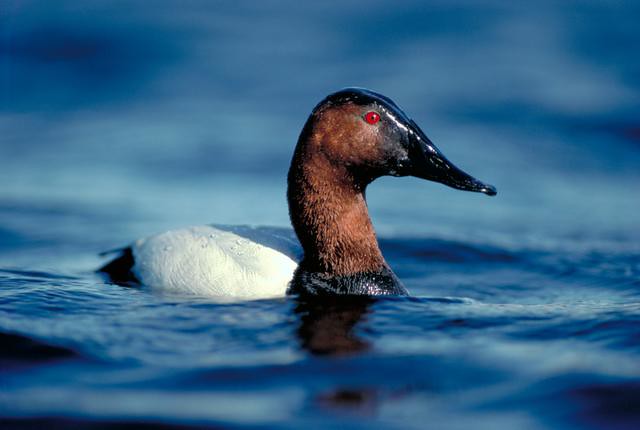
velocities of up to 124 km/h, The Canvasback (Aythya valisineria) is a species of diving duck, the largest found in North America. It ranges from 48–56 centimetres (19–22 in) in length and weighs 862–1,588 grams (1.90–3.50 lb), with a wingspan of 79–89 centimetres (31–35 in). The Canvasback has a distinctive wedge-shaped head and long graceful neck. The adult male (drake) has a black bill, a chestnut red head and neck, a black breast, a grayish back, black rump, and a blackish brown tail. The drake's sides, back, and belly are white with fine vermiculation resembling the weave of a canvas, which gave rise to the bird's common name.The bill is blackish and the legs and feet are bluish-gray. The iris is bright red in the spring, but duller in the winter. The adult female (hen) also has a black bill, a light brown head and neck, grading into a darker brown chest and foreback. The sides, flanks, and back are grayish brown. The bill is blackish and the legs and feet are bluish-gray. Its sloping profile distinguishes it from other ducks. Source: Article. Eider Duck: Eider Duck are found in the Northern
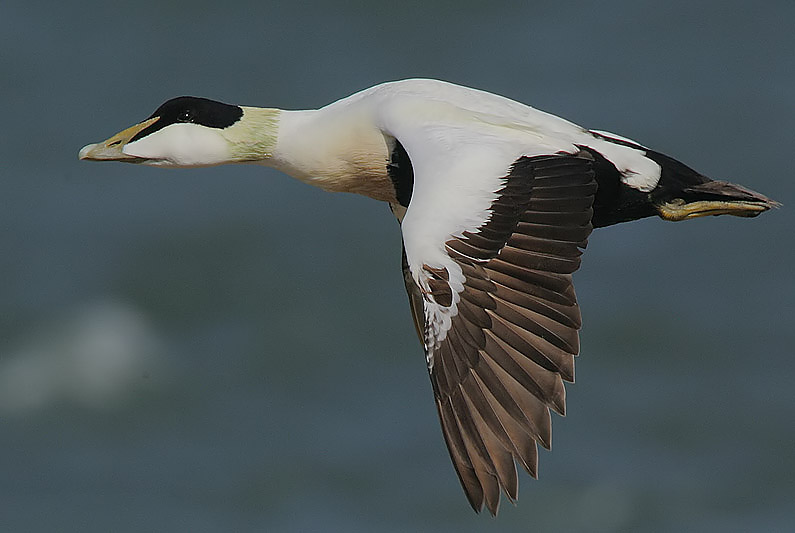
Hemisphere of the world. It is commonly reputed to reach velocities of up to 113 km/h, . The Common Eider [pronunciation?] (Somateria mollissima) is a large (50–71 cm body length) sea-duck that is distributed over the northern coasts of Europe, North America and eastern Siberia. It breeds in Arctic and some northern temperate regions, but winters somewhat farther south in temperate zones, when it can form large flocks on coastal waters. It can fly at speeds up to 113 km/h (70 mph). The eider's nest is built close to the sea and is lined with the celebrated eiderdown, plucked from the female's breast. This soft and warm lining has long been harvested for filling pillows and quilts, but in more recent years has been largely replaced by down from domestic farm-geese and synthetic alternatives. Although eiderdown pillows or quilts are now a rarity, eiderdown harvesting continues and is sustainable, as it can be done after the ducklings leave the nest with no harm to the birds. Source: Article. Teal: It is commonly reputed to reach velocities of up to 109 km/h, The Eurasian Teal or

"Anas carolinensis (Green-winged Teal) male" by Jeslu - Flickr. Licensed under CC BY 2.0 via Commons.
Common Teal (Anas crecca) is a common and widespread duck which breeds in temperate Eurasia and migrates south in winter. The Eurasian Teal is often called simply the Teal due to being the only one of these small dabbling ducks in much of its range. The bird gives its name to the blue-green colour teal. It is a highly gregarious duck outside the breeding season and can form large flocks. It is commonly found in sheltered wetlands and feeds on seeds and aquatic invertebrates. The North American Green-winged Teal (A. carolinensis) was formerly (and sometimes is still) considered a subspecies ofA. crecca. The Eurasian Teal is the smallest extant dabbling duck at 34–43 cm (13–17 in) length and with an average weight of 360 g (13 oz) in drake (males) and 340 g (12 oz) in hens (females). The wings are 17.5–20.4 cm (6.9–8.0 in) long, yielding a wingspan of 53–59 cm (21–23 in). The bill measures 3.2–4 cm (1.3–1.6 in) in length, and the tarsus 2.8–3.4 cm (1.1–1.3 in). Source: Article. Mallard Duck: It is commonly reputed to reach velocities of up to 105 km/h..
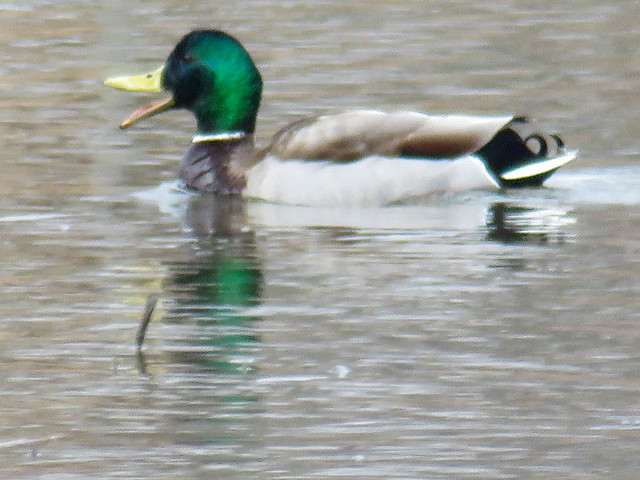
The Mallard (ˈmælɑrd/ or /ˈmælərd/) or Wild Duck (Anas platyrhynchos) is a dabbling duck which breeds throughout the temperate and subtropical Americas, Europe, Asia, and North Africa, and has been introduced to New Zealand and Australia. This duck belongs to the subfamily Anatinae of the waterfowl family Anatidae. The male birds (drakes) have a glossy green head and are grey on wings and belly, while the females have mainly brown-speckled plumage. Mallards live in wetlands, eat water plants and small animals, and are gregarious. This species is the ancestor of most breeds of domestic ducks. Pintail Duck: Pintail Duck is also one of the sharpest bird
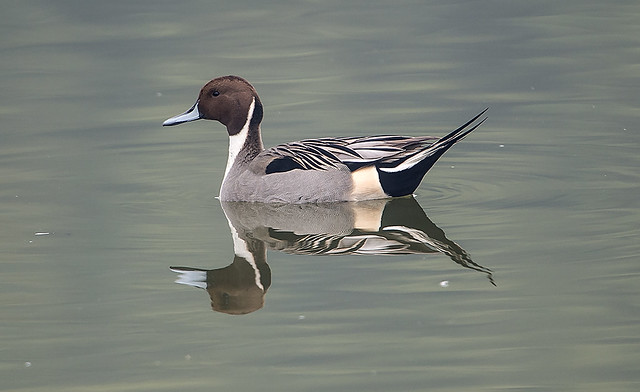  camera has helped show that the hummingbird is not only the fastest moving living thing on Earth but is also the fastest shaker. The camera, which is capable of capturing images at up to 650,000 frames per second, caught the birds shimmying at a rate that was 10 times faster than a dog after it takes a bath. Andreas Pena Doll and Rivers Ingersoll, both students in David Lentink's lab at Stanford University, captured Anna's hummingbirds shaking their tiny bodies 55 times per second while they were in flight, New Scientist reported. Lentink observed that it is the fastest shake by any vertebrate on Earth. Pena Doll said that the shimmy done in dry weather could remove pollen or dirt from their feathers similar to the way a wet shake removes water. The study will be published in the Journal for Biomechanics of Flight. (ANI). Source: Article.
Colorful

not always what they might seem. Have you ever wondered why grackles look iridescent blue in good light and black in bad light? Or why the colorful gorgets of male hummingbirds appear and then disappear without warning? This is because color in birds is not a simple thing. But rather it is a complex concoction of some very specific recipes. There are two main ingredients that are essential in the making of color. The first is pigment and the second is keratin. And the ways in which these two fundamental ingredients are added to the color cooking pot are what produces the final colors that we see. Pigments are relatively simple color makers. There are three main pigments that give feathers their colors. The first pigment is called melanin and it produces black or dark brown coloration. Melanin is also very strong and is thus often reserved for the flight feathers. White feathers are caused by a lack of pigmentation and are much weaker than black feathers due to the lack of melanin. This might explain why many predominantly-white bird species have entirely black or black-tipped feathers in their wings. These feathers are exposed to the greatest wear
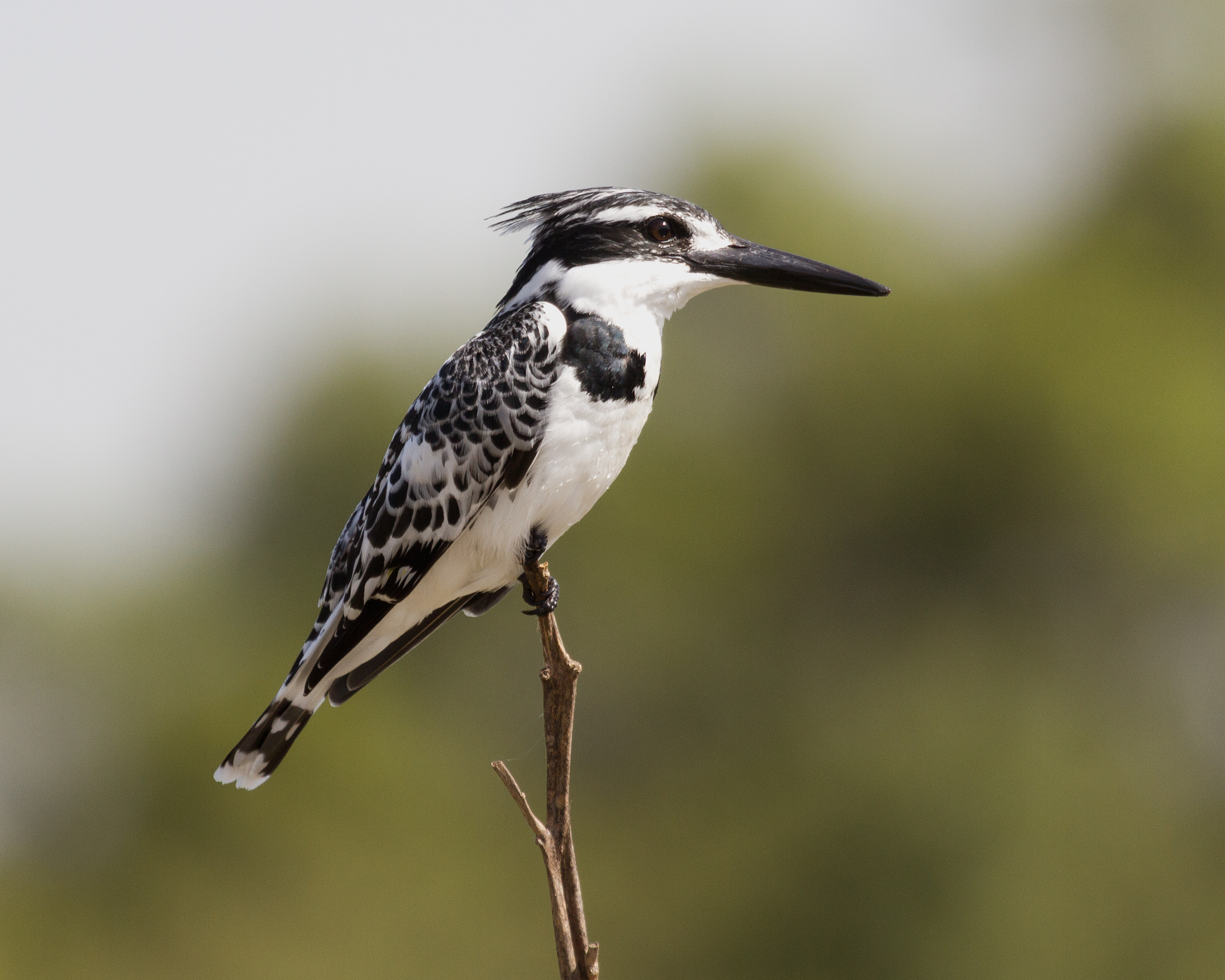
"Pied kingfisher" by Вых Пыхманн - Own work. Licensed under CC BY-SA 3.0 via Commons.
and are required to be stronger than regular feathers. The second group of pigments are called carotenoids and they produce red, orange or yellow feathers. Carotenoids are produced by plants. When birds ingest either plant matter or something that has eaten a plant, they also ingest the carotenoids that produce the colors in their feathers. The pink color of flamingoes, for example, is derived from carotenoids found in the

"Piranga olivacea1". Licensed under Public Domain via Commons.
crustaceans and algae that the birds sieve from the water. The third group of pigments are called porphyrins and these are essentially modified amino acids. Porphyrins can produce red, brown, pink and green colors. This pigment group is the rarest of the three pigment groups and is found in only a handful of bird families. The best-known example of porphyrins is the red pigment (often called turacin) that is found in many turaco species and turacoverdin, the green pigment found in many of the same turaco

species. Mixtures of pigments can also produce different and unusual color hues and shades. For example, the dull olive-green colors of certain forest birds is actually a mixture of yellow carotenoid pigments and dark-brown melanin pigments. Then we get to the second main ingredient that produces color: keratin. Keratin is the tough protein of which feathers are made. It also covers birds’ bills, feet and legs. Keratin is responsible for the iridescent coloring of many spectacular bird species. How keratin produces color is a rather complex process but, from what I’ve read on the subject, I shall attempt to simplify it as follows. Keratin produces color in two main ways: by layering and by scattering. Layering colors are produced when translucent keratin reflects short wave-lengths of colors like blues, violets, purples and greens. The other colors are absorbed by an underlying melanin (black) layer. The ways in which the keratin of the feathers are layered will dictate the color of the iridescence. Examples of layered coloring include the iridescence of glossy starlings and the speculums or wing patches of many duck species. Scattering is produced when the keratin of feathers is interspersed with tiny air pockets within the structure of the feathers themselves.
"Merops ornatus - Centenary Lakes" by JJ Harrison (jjharrison89@facebook.com) - Own work. Licensed under CC BY 3.0 via Commons.
These air pockets and the interspersed keratin scatter blue and green light and produce the shimmering colors of birds like kingfishers, rollers and bee-eaters. The magnificence of some of these scattered colors is wonderfully exhibited in Adam Riley’s post on the “Bee-eaters of Africa”. And like any really good dish, there are times when several ingredients need to be mixed together to produce a really good recipe. And both keratin and pigments can be combined to produce certain colors. The greens of many parrot species are caused by blue scattered light (produced by keratin) interacting with yellow carotenoids (produced by pigments in the feathers). Grey feathers are produced by the blend of scattered white light and melanin pigments. Learning a little about how color is shaped in birds now presents me with an fully new birding defy when out in the field: figuring out the various color recipes that birds use to dazzle. Source-Link. Rare Colorful Birds Around the World:

"Wilson's Bird of Paradise Best" by Serhanoksay - Own work. Licensed under CC BY-SA 3.0 via Commons.
The Wilson's Bird-of-paradise, Cicinnurus respublica, is a small, up to 21 cm long, passerine bird of the Paradisaeidae family. The male is a red and black bird-of-paradise, with a yellow mantle on its neck, light green mouth, rich blue feet and two curved violet tail feathers. The head is naked blue, with black double cross pattern on it. The female is a brownish bird with bare blue crown. In the field, the blue bare skin on the crown of the bird's head is so vivid that it is clearly visible by night; the deep scarlet back and velvet green breast are lush, the curlicue tail gleaming bright silver. An Indonesian endemic, the Wilson's Bird-of-paradise is distributed to the hill and lowland rainforests of Waigeo and Batanta Islands off West Papua. The diet consists mainly of fruits and small insects. The controversial scientific name of this species was given by Charles Lucien Bonaparte, Napoleon's nephew and a republican idealist, who described the bird from a badly damaged trade specimen purchased by British ornithologist Edward Wilson. In doing so, he beat John Cassin, who wanted to name the bird in honor of Wilson, by several months. Thirteen years later, in 1863, the German zoologist[term zoo studies] Heinrich Agathon Bernsteindiscovered the home grounds of the Wilson's Bird-of-paradise in Waigeo Island. Due to ongoing habitat loss, limited range and exploitation, the Wilson's Bird-of-paradise is evaluated as Near Threatened on the IUCN Red List of Threatened Species. It is listed on Appendix II of CITES. The first footage of the Wilson's Bird-of-paradise ever to be filmed was recorded in 1996 by David Attenborough for the BBC documentary Attenborough in Paradise. He did so by dropping leaves on the forest floor, which irritated the bird into clearing them away. Source: Article

"Erythropitta erythrogaster" by http://www.flickr.com/photos/79492850@N00/ - Licensed under CC BY 2.0 via Commons.
The Red-bellied Pitta (Erythropitta erythrogaster) is a species of bird in the Pittidae family, found in Australia, Indonesia, Papua New Guinea, Philippines. Its natural habitat is subtropical or tropical moist lowland forests. Source: Article
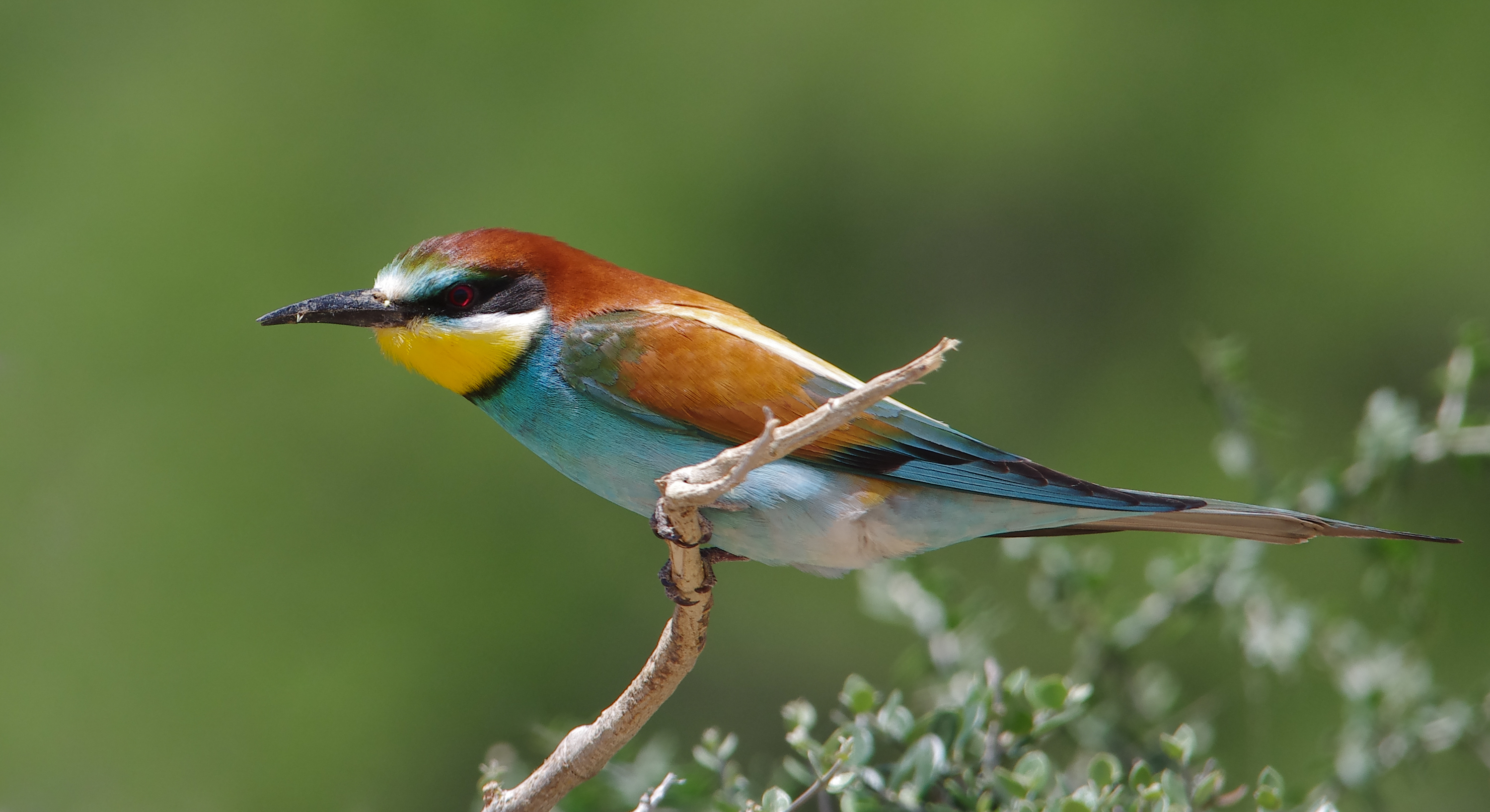
"Guepier d'europe au parc national Ichkeul" by Elgollimoh - Own work. Licensed under CC BY-SA 3.0 via Commons.
The European Bee-eater (Merops apiaster) is a near passerine bird in the bee-eater family Meropidae. It breeds in southern Europe and in parts of north Africa and western Asia. It is strongly migratory, wintering in tropical Africa, India and Sri Lanka. This species occurs as a spring overshoot north of its range, with occasional breeding in northwest Europe. This is a bird which breeds in open country in warmer climates. Just as the name suggests, bee-eaters predominantly eat insects, especially bees, wasps and hornets which are caught in the air by sorties from an open perch. Before eating its meal, a European Bee-eater removes the sting by repeatedly hitting the insect on a hard surface. It eats some 250 bees daily.[citation needed] Lizards and frogs are also taken.[citation needed]The most important prey item in their diet are Hymenoptera, mostly Apis mellifera; a study in Spain found that these comprise 69.4% to 82% of the European bee-eaters' diet Their impact on bee populations however is small; they eat less than 1% of the worker bees in the area in which they live. A study found that European bee-eaters "convert food to body weight more efficiently if they are fed a mixture of bees and dragonflies than if they eat only bees or only dragonfiles. Source: Article
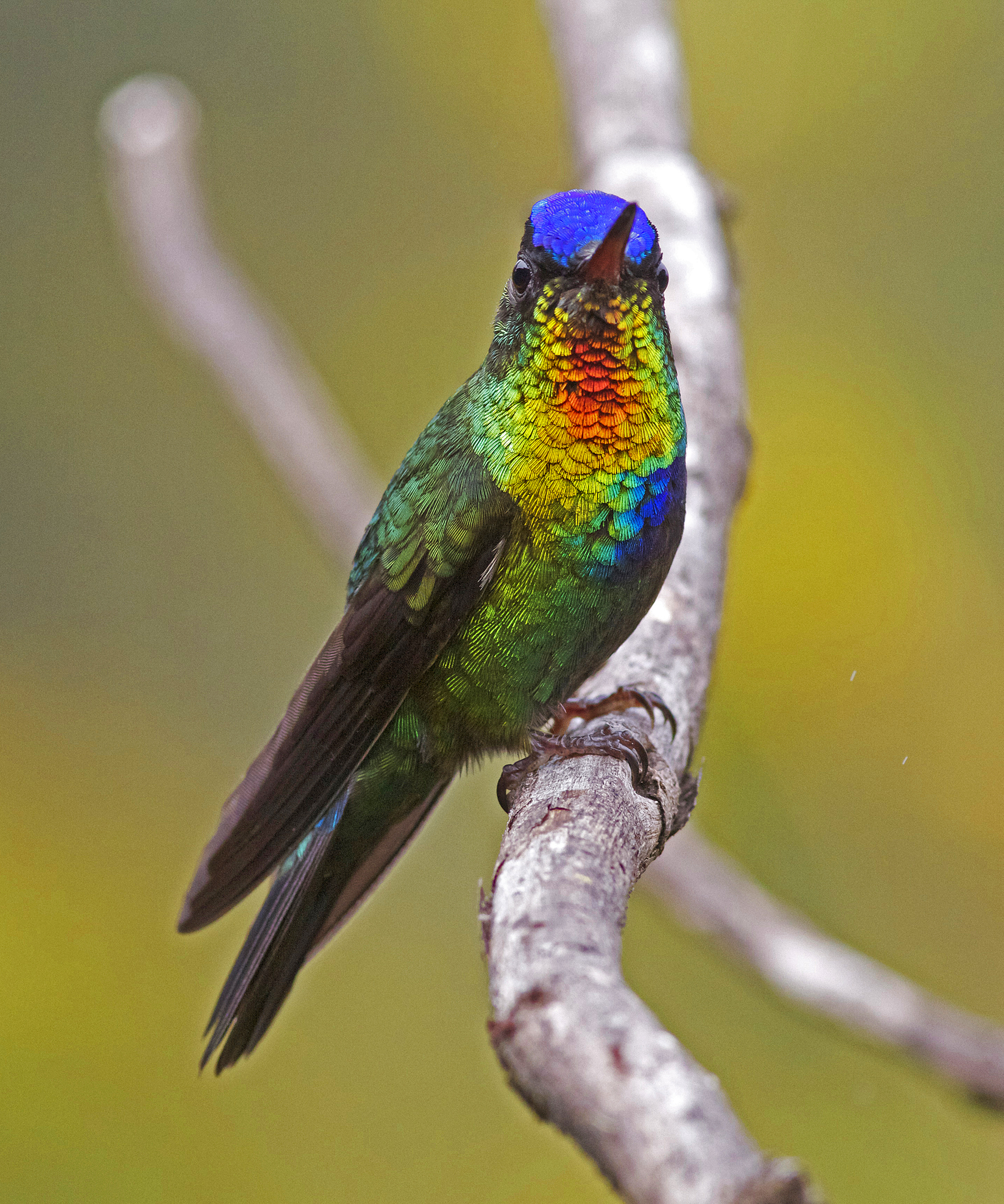
"Fiery throated Hummingbird JCB2" by Joseph C Boone - Own work. Licensed under CC BY-SA 3.0 via Commons.
The Fiery-throated Hummingbird (Panterpe insignis) is a medium-sized hummingbird which breeds only in the mountains of Costa Rica and western Panama. It is the only member of the genus Panterpe. This is a common to abundant bird of montane forest canopy above 1400 m, and also occurs in scrub at the woodland edges and clearings. This bird is 11 cm long and weighs 5.7 g. It has a straight black bill and dusky feet. The adult Fiery-throated Hummingbird has shiny green body plumage, a blue tail, and a white spot behind the eye. It often looks dark, but when the light catches it at the right angle, it shows a brilliant blue crown, yellow-bordered bright orange throat, and blue chest patch. The sexes are similar, but young birds have rufous fringes to the head plumage. The call is a high-pitched twittering. The female Fiery-throated Hummingbird is entirely responsible for nest building and incubation. She lays two white eggs in a bulky plant-fibre cup nest 2–4 m high at the end of a descending bamboo stem or on a rootlet under a bank. Incubation takes 15–19 days, and fledging another 20-26. Very little color from the side. The food of this species is nectar, taken from a variety of small flowers, including epiphytic Ericaceae, bromeliads. Like other hummingbirds it also takes small insects as an essential source of protein. Male Fiery-throated Hummingbird defend flowers and scrubs in their feeding territories, and are dominant over most other hummingbirds. They will, however, allow females to share their food resources. Source: Article

"Common Flame-back Woodpecker" by Flickr user NatureAtYourBackyard . Licensed under CC BY 2.0 via Commons.
The flamebacks or goldenbacks are large woodpeckers which are resident breeders in tropical southern Asia. They derive their English names from their golden or crimson backs. However, the two flameback genera Dinopium and Chrysocolaptes are not particularly close relatives. The former are close to the enigmatic Meiglyptes and possibly Hemicircus woodpeckers, and the recently-reclassified Rufous Woodpecker (Micropternus brachyurus). Chrysocolaptes on the other hand appears to be a rather close relative of Campephilus, the genus of the famous Ivory-billed Woodpecker. Source: Article, The Greater Flameback (Chrysocolaptes guttacristatus ) also known as Greater Goldenback, Large Golden-backed Woodpecker or Malherbe's Golden-backed Woodpecker, is a woodpecker species. It occurs widely in the Indian subcontinent, eastwards to southern China, the Malay Peninsula, Sumatra, western and central Java and northeast Borneo. The Greater Flameback is a large woodpecker, at 33 cm in length. It is of typical woodpecker shape, has an erect crest and a long neck. Coloration is highly variable between subspecies; it always has unmarked golden-yellow to dark brown back and wings. The rump is red and the tail is black. The underparts are white with dark markings (chevrons, stripes, or bands), or light brown. The head is whitish with a black pattern, or it is yellow, brown or red. The straight pointed bill is long (longer than the head) and – like the legs and four-toed zygodactyl feet (two toes pointing forward, two backward) – lead-grey. The eyes' irides are whitish to yellow. The adult male Greater Flameback always has a red crown. Females have a crown color varying between subspecies, such as black spotted with white, yellow, or brown with lighter dots. Young birds are like the female, but duller, with brown irides Source: Article

"Tauraco persa -captive-8a" by www.opencage photographer - Open Cage. Licensed under CC BY-SA 2.5 via Commons.
The Guinea Turaco (Tauraco persa), also known as the Green Turaco, is a species of turaco, a group of near-passerines birds. It is found in forests of West and Central Africa, ranging from Senegal east to DR Congo and south to northern Angola. It lays two eggs in a tree platform nest. It formerly included the Livingstone's, Schalow's, Knysna, Black-billed and Fischer's Turacos as subspecies. persa buffoni is the only subspecies of the Guinea Turaco without a white line below the eye The Guinea Turaco, often inconspicuous in the treetops, is approximately 43 cm long, including a long tail. The plumage is largely green and the tail and wings are dark purplish, except for the crimson primary feathers that are very distinct in flight. In the westernmost subspecies buffoni, which sometimes is known as the Buffon's Turaco, there is a white line above and in front of the eye and a black line below the eye. In the nominate subspecies of the central part of its range and zenkeri of the southeastern part there also is a second white line below the black line. Unlike similar turacos with red bills, even adult Guinea Turacos lack a white rear edge to the crest. This species is a common in climax forest with plentiful tall trees. It feeds on fruit and blossoms. Source: Article
The Golden Pheasant or "Chinese Pheasant", (Chrysolophus pictus) is a gamebird of the order Galliformes (gallinaceous birds) and the family Phasianidae. It is native to forests in mountainous areas of western China, but feral populations have been established in the United Kingdom and elsewhere. In England they may be found in East Anglia in the dense forest landscape of the Breckland. The adult male is 90–105 cm in length, its tail accounting for two-thirds of the total length. It is unmistakable with its golden crest and rump and bright red body. The deep orange "cape" can be spread in display, appearing as an alternating black and orange fan that covers all of the face except its bright yellow eye with a pinpoint black pupil. Males have a golden-yellow crest with a hint of red at the tip. The face, throat, chin, and the sides of neck are rusty tan. The wattles and orbital skin are both yellow in colour, and the ruff or cape is light orange. The upper back is green and the rest of the back and rump is golden-yellow. The tertiaries are blue whereas the scapulars are dark red. Other characteristics of the male plumage are the central tail feathers, black spotted with cinnamon, as well as the tip of the tail being a cinnamon buff. The upper tail coverts are the same colour as the central tail feathers. The male also has a scarlet breast, and scarlet and light chestnut flanks and underparts. Lower legs and feet are a dull yellow. The female (hen) is much less showy, with a duller mottled brown plumage similar to that of the female Common Pheasant. She is darker and more slender than the hen of that species, with a proportionately longer tail (half her 60–80 cm length). The female's breast and sides are barred buff and blackish brown, and the abdomen is plain buff. She has a buff face and throat. Some abnormal females may later in their lifetime get some male plumage. Lower legs and feet are a dull yellow. Both males and females have yellow legs and yellow bills. Despite the male's showy appearance, these hardy birds are very difficult to see in their natural habitat, which is dense, dark young conifer forests with sparse undergrowth. Consequently, little is known about their behaviour in the wild. They feed on the ground on grain, leaves and invertebrates, but they roost in trees at night. While they can fly, they prefer to run. If startled, they can suddenly burst upwards at great speed and with a distinctive wing sound. Although they can fly in short bursts, they are quite clumsy in flight and spend most of their time on the ground. Golden Pheasants lay 8-12 eggs at a time and will then incubate these for around 22–23 days. They tend to eat berries, grubs, seeds and other types of vegetation. The male has a metallic call in the breeding season. The Golden Pheasant is commonly found in zoos and aviaries, but often as impure specimens that have the similar Lady Amherst's Pheasant in their lineage. There are also different mutations of the Golden Pheasant known from birds in captivity, including the Dark-throated, Yellow, Cinnamon, Salmon, Peach, Splash, Mahogony and Silver. In aviculture, the wild type is referred to as "Red Golden" to differentiate it from these mutations. Source: Article1, Article2. Blue Jay around the world: The Blue Jay (Cyanocitta cristata) is a passerine bird in the
"Portrait of a Golden Pheasant" by Bjørn Christian Tørrissen, Licensed under CC BY-SA 3.0 via Commons.
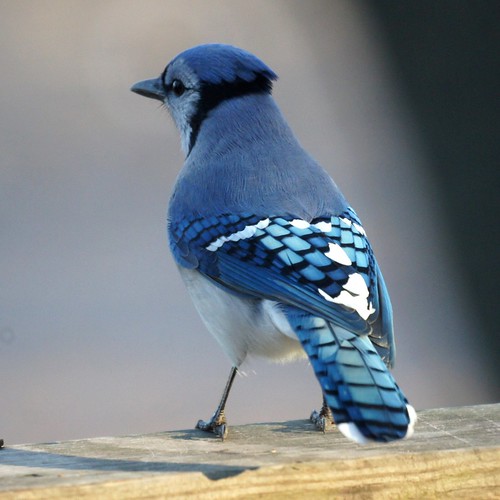 family Corvidae, native to North America. It is resident through most of eastern and central United States and southern Canada, although western populations may be migratory. It breeds in both deciduous and coniferous forests, and common  near in residential areas. and is It is predominately blue with a white chest and underparts, and a blue crest. It has a black, U-shaped collar around its neck and a black border behind the crest. Sexes are similar in size and plumage does 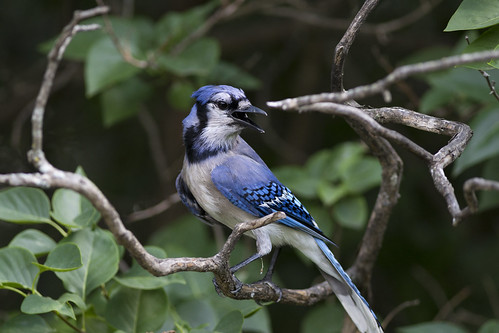 not vary throughout the year. Four subspecies of the Blue Jay are recognized. The Blue Jay mainly feeds on nuts and seeds such as acorns, soft fruits, arthropods, and occasionally small vertebrates. It typically gleans food from trees, shrubs, and the ground, though it sometimes hawks insects from the air. It builds an open cup nest 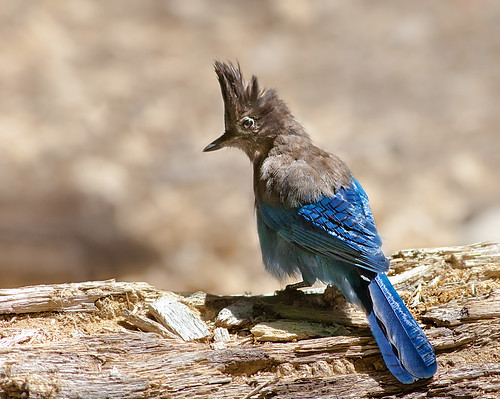 in the branches of a tree, which both The sexes participate in constructing. clutch can contain two to seven eggs, which are blueish or light brown with brown spots. Young are altricial, and are brooded by the female for 8–12 days after hatching. They may remain with their parents for one to two months. The bird's name derives from its noisy, garrulous nature, and it sometimes also called a "jaybird". Source: Article. Exotic Birds Endemic to The Philippines: The Philippines is home to some of the world’s most exotic birds. With more than 600 bird species to choose from including several species of hornbills, colorful fruit doves, rare parrots and fascinating eagles and owls — its really fun to explore and learn more about these beautiful and unique birds. Here is a list of 12 exotic birdsendemic to this “bird-paradise” country. Each country has its own unique variety of birds native to its geographical location. The Philippines is home to some of the world’s most exotic birds, too. It is believed that 185 of these species can be found only in the Philippines. Sad to say, these birds are faced with the threat of eventual death, as of deforestation & human threat. Let me show you to some of the Philippines exotic-birds 
"Handsome sunbird" by Llimchiu at en.wikipedia. Licensed under CC BY-SA 3.0 via Commons.
The Handsome Sunbird: Sunbird The Handsome (Aethopyga bella) is found only in the Philippines. It is one of the smallest sunbirds. Handsome songbirds inhabit subtropical or tropical moist lowland forests and subtropical or tropical moist mountain habitat. They maybe seen singly or in pairs frequenting flowering & fruiting trees. About 254 mm total length, they feed on nectar as well as small insects.

"Actenoides lindsayi -Philippines -male-8" by Doing BIG YEAR! - Spotted-Wood Kingfisher. Licensed under CC BY 2.0 via Commons.
The Spotted Wood Kingfisher: The Spotted Wood Kingfisher (Actenoides lindsayi) is endemic to the Philippines widespread in Lizon, Panay, Negros, Marinduque and Catanduanes. It inhabits subtropical or tropical moist lowland forests, perches static in dark recesses. It measures around 254 mm long & also classified as Least Concern.

The Palawan Leafbird: The Yellow-throated Leafbird (Chloropsis palawanensis) is a small bird endemic to the Palawan and the Calamian Groupin the Philippines. It commonly inhabits forest, forest edge, and scrub. With a distinctive green color, it measures to about 15.8 – 17.2 cm long. It has pointed slender bill, yellow throat, broad wings and long dull blue tail. Feeds on fruits and seeds. it is sorted as least Concern.
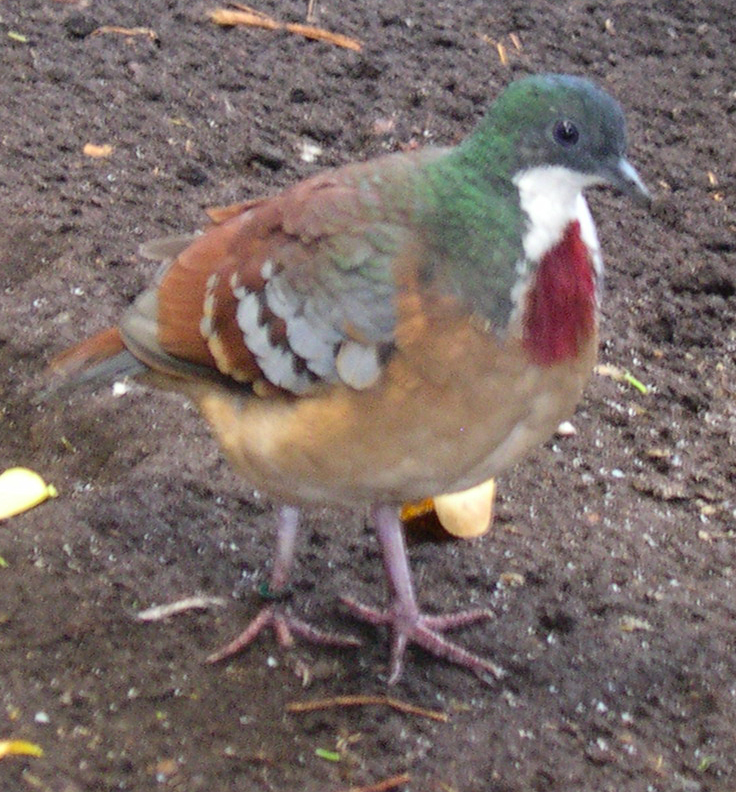
"Gallicolumba criniger" by Magalhães from nl. Licensed under CC BY-SA 3.0 via Commons.
The Luzon Bleeding-heart: The Luzon Bleeding-heart (Gallicolumba luzonica) known for the splash of vivid red color at the heart of their white breasts, is a ground dove endemic to the central and southern parts of Luzon, and Polillo Islands, in the Philippines. Thisspecies is found in lowland forest (below 1,400 m). Generally slate grey in color, it measures about 25 cm long and weighs about 150-200 g. It has round body, black bill, a short tail and long red legs. It feeds primarily on seeds, fallen berries, grubs, insects, and worms. The species is threatened by habitat loss, and rampant hunting. it is classified as Near Threatened. The Luzon Bleeding-heart (Gallicolumba luzonica) is one of a number of species of ground dove in the genus Gallicolumba that are called "bleeding-hearts". They get this name from a splash of vivid red colour at the centre of their white breasts. The Luzon Bleeding-heart is the species in which this feature is most pronounced, and on first sight it is hard to believe that the bird has not recently been wounded. A reddish hue that extends down the belly furthers the illusion of blood having run down the bird's front. Source: Article

"Ptilinopus occipitalis -zoo -adult-8a" by jojo nicdao from muntinlupa 20120226-DSC_2997.jpg Licensed under CC BY 2.0 via Commons.
The Yellow-breasted Fruit Dove: The Yellow-breasted Fruit Dove (Ptilinopus occipitalis), locally called Punay, is one of the five endemic fruit-dovesendemic to the Philippines. This colorful dove is widespread over the country except the Palawan region. This speciesinhabit lowland and mid elevation forests and are seen singly or in pairs. Generally, they are frugivores ( animals that eats mainly fruits). Adults reach 28-33cm in length and weigh about 204-278g. The species is Not globally threatened.
The Philippine Cockatoo: The Red-vented Cockatoo (Cacatua haematuropygia), popularly known as the Philippine Cockatoo is a critically endangered bird native to the Philippines. Its natural habitat includes mangrove forests, lowlands, forest edges and riverine. The Katala as it is locally called, measures about 33 centimeters in length with an 8.6 inches wingspan and weighs 0.29 kilogram. It is easily recognized by its all-white plumage and by the red feathers around the vent. A highly-social species, they can be seen in groups of up to 30 or more. It feeds on the seeds and fruits of wild trees. The Red-vented Cockatoo is classified Critically Endangered due to habitat loss and rampant pouching. Source: Article. Bornean Peacock Pheasant Amazing Birds: The Bornean Peacock-pheasant (see Remarks 1) is
"Cacatua haematuropygia -Palawan, Philippines-8" by jacobusmulder - Picasa Web Albums. Licensed under CC BY-SA 3.0 via Commons.

"Bornean Peacock Pheasant by George Edward Lodge" by George Edward Lodge - A Monograph
endemic to the island of Borneo, where it has been recorded to date from Sabah and Sarawak, Malaysia, and Kalimantan, Indonesia. The following account has drawn extensively on a compilation of important new evidence by Sözer et al. (ms a), as part of the results of their “Kalimantan Pheasant Project”, and grateful acknowledgement is made here to the authors for free access to this material. Records are from: Indonesia and Malaysia. INDONESIA :Kalimantan n East Kalimantan (see Remarks 5) “Kemawen”, i.e. Kihammawon, September 1969 (male in MZB; also van Balen and Holmes 1993); Danumparoy in the Ratah river headwaters, c.160 m, feathers shown of a bird taken some years before January 1996 (Sözer et al. ms a); Ma’au, 75 m, near tributaries of the Ratah, three birds trapped, July–September 1996 (Sözer et al. ms a); Sungai Wain Nature Reserve, March–April 1998 (G. Fredriksson per SvB, and in Sözer et al. ms a), with a dead male, apparently eaten by a civet, 120 m in primary dipterocarp forest, May 2000, and an apparent female along a track on a ridge near the same spot, July 2000 (G. Fredriksson in litt. 2000); Sungai Apa, a small tributary of the upper Marikoi river, near Tumbang Korik village, 150 m, feathers shown of one of three birds taken in or around April 1996 (Sözer et al. ms a); Balikpapan Bay, February 1909 (Smythies 1981, specimen in USNM); n Central Kalimantan Tumbang Maruwei, on the Barito river, c.70 km north of Muara Teweh, where two males and a bundle of male tail feathers were collected in September–November 1915 (Voous 1961); Muarateweh (type locality), on the Teweh river, mid-1870s (Brüggemann 1877, 1878), with a male and female collected there in the late 1870s (von Pelzeln 1879, 1880; see Remarks 6); Sungai Marikoi, 150 m, feathers shown of a bird taken in July 1996 (Sözer et al. ms a); Kualakurun, (100 km north of) Palangkaraya, March 1979 (specimen in MZB; see Remarks 7, also Remarks 6); Sungai Ewang, between the Senamang and Bemban rivers, feathers shown of a bird taken in 1990–1991 (Sözer et al. ms a); Kiham Batang, 200 m, upper Senamang river, November 1996 (T. O’Brien in litt. 2000, Sözer et al. ms a); Barito Ulu, by local report, 1989 (Dutson 1990); n West Kalimantan (see Remarks 2) Danau Sentarum, by local report (Hood 1993, van Balen 1996c, O’Brien et al. 1998b), with five birds trapped north north-west of Danau Sentarum National Park, 150 m, March 1998 and August 1999 (Sözer et al. ms a); Nangapinoh within the Pt Erna Timber Concession, 120 m, a total of 14 birds trapped for trade between December 1997 and August 1998 (Sözer et al. ms a); Muara Penyelayan, 150 m, November 1997 (Sözer et al. ms a); Sopan Unke, 140 m, near the Penyelayan river, feathers found of a bird taken in November 1997 (Sözer et al. ms a); between Pontianak and Banjarmasin, 1948–1949 (Delacour 1977). A combination of these recent results with the older records and with anecdotal evidence provided by reliable local witnesses results in roughly 17 clusters of sites in Kalimantan within which the Bornean Peacock-pheasant is felt likely to be present, as follows: (East Kalimantan) Ratah river; Pari and Maribu rivers; Gunung Lumut; Gunung Beratus–Balikpapan Bay–Lawa river–Kedang river; upper Kedangpahu river; upper Kelau river; (Central Kalimantan) Senamang river; upper Kahayan river; Murui river; south of the upper Barito river; upper Barito, Murung and Maruwei rivers; (South Kalimantan) Pitap river (Gunung Besar); (West Kalimantan) north-west of Danau Sentarum; Sandai-Nangatayap; west of Bukit Baka and Bukit Raya; Nanganinoh; and Serawai river. Throughout Borneo the species has been judged “extremely rare” (Smythies 1981, Mann in prep.). The total population was reckoned to be under 1,000 in 1995 (McGowan and Garson 1995). The problem with assessing its status is that it is likely to be patchily distributed according to a particular and as yet weakly understood habitat preference or circumstance (see Measures Proposed). Quantification of decline in this species has been attempted, but this exercise was greatly hampered by paucity of data: eight localities were traced, seven before and one after 1970 (i.e. none shared) (McGowan et al. 1998a). In the present review, 21 localities have been identified, eight before and 13 after 1980. Nevertheless and notwithstanding the numbers estimated for Kalimantan below the decline of this lowland forest species must have been precipitate in the past few decades owing to habitat loss compounded by other human pressures (see Threats). This Bornean Peacock Pheasant is a bird of lowland dipterocarp and alluvial forest, ranging from sea-level to 1,000 m (Mann in prep.), and its favoured habitat has been thought to be riverine forest, a severely threatened forest type (van Balen and Holmes 1993). By contrast, local people report this species to occupy lowland primary forest but seemingly keeping clear of wetter substrates in swamp forest or near waterbodies, and GIS analysis of these records suggests that the habitat is lowland plain and lowland dipterocarp forest onmoderately fertile soils (O’Brien et al. 1998b). Despite misgivings about the sources of this information (see Population), in general other parallel studies have yielded the same results: recent confirmed records come from secondary and primary lowland dipterocarp forest along rivers, the lower parts of primary hill (but still under 200 m) dipterocarp forest, and temporarily dry swamp forest, with the species preferring forest on the black, more fertile (alluvial) soils and always being trapped near smaller rivers or streams (Sözer et al. ms a). Calling heard in Sabah, August 1998, came from close to a small stream flowing into a larger river, typical of habitat of Malaysian Peacock-pheasant (J. Corder in litt. 1999) but the caller may have been a kingfisher (see Remarks 2). In Sarawak there is a record from “steep slope forest” (McGowan and Garson 1995). Source: animaldiscovery-chanel, Most beautiful birds in Indonesia: Indonesia is a country that has three thousand more diversity of species and number one as the country's largest owner of species in the world, like the endangered species of birds unique which the most beautiful in the world, includes the amazing birds below,

"Paradisaea rudolphi by Bowdler Sharpe" by Richard Bowdler Sharpe - http://www.oiseaux.net/photos/bowdler.sharpe/. Licensed under Public Domain via Commons.
The Blue Paradise or the scientific name Paradisaea Rudolphi, was discovered by Carl Hunstein in 1884. the Blue Paradise is a kind of medium sized birds of paradise, with a length of about 30cm, part of the genus Paradisaea. The spread area of Blue Paradise found in the forests of the eastern highlands and the southeast of Papua Island, generally at a height of 1,400 meters to 1,800 meters altitude above sea level.
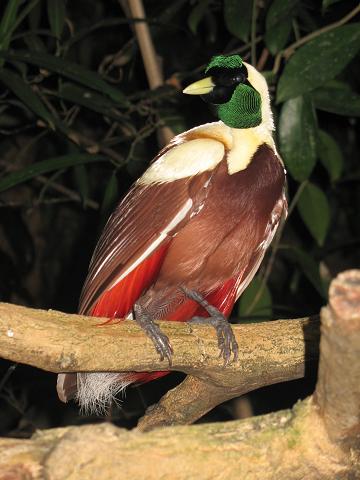
The Red Paradise or the scientific name Paradisaea Rubra is a type of warbler with sized a length of about 33cm, from the clan Paradisaea. Endemic to Indonesia, The male has an emerald green face, a pair of elongated black corkscrew-shaped tail wires, dark green feather pompoms above each eye and a train of glossy crimson red plumes with whitish tips at either side of the breast. The male measures up to 72 cm long, including the ornamental red plumes that require at least six years to fully attain. The female is similar but smaller in size, with a dark brown face and has no ornamental red plumes. the Red Paradise found only in lowland forests on the island and Batanta Waigeo in Raja Ampat, West Irian Jaya province. Source: Article.

"Peacock by Nihal Jabin" by NIHAL JABIN - Own work. Licensed under CC BY-SA 3.0 via Commons.
Blue Peacock or the Indian peacock, which the scientific name Pavo Cristatus is one of the birds of the three species of peacocks. The Blue Peacock has a glossy dark blue colored fur. Adult male birds Sized can reach 230cm in length, with a very long tail cover green metallic. The Blue Peacock population scattered in open forests with grasslands in the area eastern of Indonesia, India, Pakistan, Sri Lanka, Nepal and Bhutan. The bird is celebrated in Indian and Greek mythology and It is the national bird of India. Previously this species was found also in Bangladesh, but is now likely to have been extinct there The Indian Peafowl is listed as of Least Concern by IUCN.

Bali Starling or the scientific name Leucopsar Rothschildi is a kind of warbler-sized, approximately 25cm in length, from the genus Sturnidae. Endemic to Indonesia, Bali Starling is only found in the woods west of the island of Bali. This bird is also the only endemic species of Bali, which in 1991 was listed as the fauna symbol of Bali province. The existence of this endemic animals are protected by law.

The Cekakak forest has a unique voice and distinctive. In general, they are loud. Whistling high and reads "kwii-kwii ...". Uniquely, each whistle is produced approximately one note per second. Cekakak-sized forests wither, length 23 cm, while the blue fur and red rust. Cekakak-forest males have wings like a blue coat, his lower body rust red, and has a black line on the eye. Birds of this species living in the woods and hunt from a low perch. Unlike the loud voice, this bird is rather shy. They only seek their prey from the ground to keep turning the leaves.
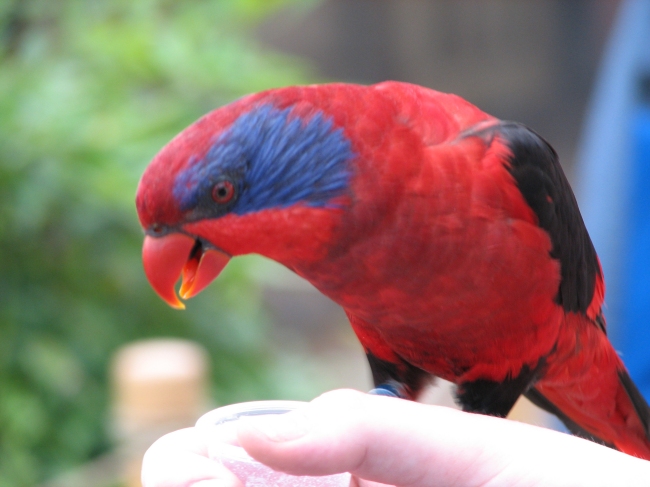
"BlackWingedLorikeet" by No machine-readable author provided.
Ltshears assumed (based on copyright claims). - No machine-readable source provided.
Own work assumed (based on copyright claims).. Licensed under Public Domain via Commons.
The black wing parrot or the red backs parrot, the scientific name Cyanogenia Eos is a kind of parrot sized, with a length of about 30cm, from the genus Psittacidae. Endemic to Indonesia, parrot black wings are found only in forest habitat on the coastal island of Biak and the islands of the Gulf of Paradise, Papua. This species is often found nesting in the plantations of coconut. This species lives at an altitude of 0-1520 feet above sea level, they usually live in the groups. Due to ongoing habitat loss, small population size & hunted in some areas, the it is valued Vulnerable on IUCN List of Threatened Species, listed on Appendix II of CITES

derivative work: Snowmanradio (talk) - originally posted to Flickr as Galah (Eolophus roseicapilla) and
uploaded to Eolophus_roseicapilla_-Wamboin,_NSW,_Australia_-adult-8.jpg. Licensed under CC BY 2.0 via Commons.
.
 . . . .
Cockatoo generally long lived, until reaching 60 years even more. Cockatoo inhabits primary and secondary forests are high and the forest edge; also monsoon forests (Nusa Tenggara), shrub forest, and the forest with little of trees. The forest which from sea level to an altitude of 900 m (Sulawesi), 1520 m (Lombok), 1000 m (Sumbawa), Indonesia. Cockatoos are recognisable by the showy crests and curved bills. Their plumage is generally less colourful than that of other parrots, being mainly white, grey or black and often with coloured features in the crest, cheeks or tail. On average they are larger than other parrots; however, the Cockatiel, the smallest cockatoo species, is a small bird. The phylogenetic position of the Cockatiel remains unresolved, other than that it is one of the earliest offshoots of the cockatoo lineage. The remaining species are in two main clades. The five large black coloured cockatoos of the genus Calyptorhynchus form one branch. The second and larger branch is formed by the genus Cacatua, comprising 11 species of white-plumaged cockatoos and four monotypic genera that branched off earlier; namely the pink and white Major Mitchell's Cockatoo, the pink and grey Galah, the mainly grey Gang-gang Cockatoo and the large black-plumaged Palm Cockatoo. Cockatoos prefer to eat seeds, tubers, corms, fruit, flowers and insects. They often feed in large flocks, particularly when ground-feeding. Cockatoos are monogamous and nest in tree hollows. Some cockatoo species have been adversely affected by habitat loss, particularly from a shortage of suitable nesting hollows after large mature trees are cleared; conversely, some species have adapted well to human changes and are considered agricultural pests. Cockatoos are popular birds in aviculture but their needs are difficult to cater for. The Cockatiel is the cockatoo species that is easiest to care for and is by far the most frequently kept in captivity. White cockatoos are more commonly found in captivity than black cockatoos. black trade in wild-caught birds adds to the decline of some its species.
Blue Eared Pheasant: The Blue-eared Pheasant Beauty Birds (Crossoptilon auritum), related to the Galliformes, Phasianidae, is a rare but important bird, endemic to China. This bird is found only in the mountainous regions of Qinghai, Gansu and Sichuan provinces and the Ningxia Hui Autonomous Region (Lu and Zheng, 1998). It is listed as a ‘vulnerable bird’ in the China Red Data Book of Endangered Animals (RDB -AVES, 1996) (Zheng and Wang, 1998) and it is also ranked as a second grade key protected wildlife species in China since it is experiencing a drastic population decline. Morphologically, the Blue-eared Pheasant can be distinguished easily from other Crossoptilon species by its distinctive blue feathers. Males and females are similar except for spurs on the legs of the males above their hind toe. The top of the head is covered with black feathers, with greatly elongated white ear coverts. The Blue-eared Pheasant has no subspecies differentiation and is a typical, high elevation, cold forest bird. Some information on its biology has been reported in recent years (Liu et al., 2005; Sun et al., 2005; Wu and Liu, 2010a, 2010b, 2011). In light of this, we provide updated information on the ecology and conservation status of the Blue-eared Pheasant, by integrating published data with our field surveys in the Gaihai-zecha National Nature Reserve, in the south of Gansu Province, from 2006 to 2008.In Helan Mountain, Ningxia, the Blue eared Pheasant in winter prefers conifer forests dominated by Pinus tabulaeformis and Picea crassifolia and avoids other vegetation types. This pheasant shows a strong preference for sunny and shady slope aspects and avoids half sunny and half shady slopes. Compared with random plots, the sites used are characterized by dense vegetation of trees and shrubs, steep slopes, closed covers for hiding, shallow snow depths and high elevations. Hiding cover, tree and shrub densities, distance to water sources and slope angles are critical factors in discriminating between usage sites and random plots (Liu et al., 2005). In the forests of south Gansu, the principal foraging method for field flocks of Blue-eared Pheasants in winter consists of digging up plant roots. It is difficult for birds in tall trees and grass cover to dig for food on frozen ground, given

the weak solar radiation in coniferous forests. Therefore, these flocks prefer habitats with scattered trees and grasses during the non-breeding stage (Wu and Liu,unpublished data). In the breeding stage, the Blue-eared Pheasant in the Gaihai-zecha Reserve prefers steep slopes (average 43.36 ± 13.95°) for foraging (Fig. 1), which is similar to that of the Golden Pheasant (Chrysolophus pictus) with slope angles ranging from 30° to 50° (Shao, 1998). The disturbance by collecting potherbs and herding in local forests has affected the available area for this pheasant, which can be verified by the variation in the distances to paths between the breeding habitats and control site of this pheasant. Our study also revealed that breeding Blue-eared Pheasants prefer mid-high and high positions on slopes with greater species richness and higher cover of grass, because in these areas these conditions not only provide the seeds and roots of grasses for foraging but are

Population Status and Conservation

- This bird species Himalayan Monal an adult male has been photographed at the district of East
Sikkim in the state of Sikkim of India on 11th May 2014, during the customized birding photography
tour of GoingWild. Previously published: Yes this file has been previously published in my facebook profile; the same
has been present in India Biodiversity Portal and has also been shared with Oriental Bird Club Images.. Licensed under CC BY-SA 3.0 via Commons.
a long crest, feathered with multi-colored plumage throughout its body, while the females, like other pheasants, are dull in color with their upper parts covered with dark brownish black feathers. Notable features in males are their long crest which is metallic green, changeable reddish copper in the back and sides of the neck and a prominent white back while in flight. Tail feathers of the male are uniformly rufous, darker towards the tips, while the lower tail coverts of the female are white, barred with black and rufous. The female has a prominent white patch in the fore neck and a white strip on the tail. First year males are immature and resemble female chicks, but are larger in the first year and their immaturity is less pronounced (Delacour, 1977). It is also one of the best recognized pheasant species of the western Himalayas because of the metallic, rainbow-colored plumage, iridescent blue head crest and highly exhibited sexual dimorphism of the male. These characteristics have qualified this mountainous forest bird to the status as national bird of Nepal and the state bird of Uttaranchal and Himalchal Pradesh in India (Ramesh et al., 1999; Ramesh, 2003). Distribution: The natural range of the the Himalayan Monal spreads from eastern Afghanistan through the Himalayas, including Pakistan, India (the state of Jammu & Kashmir, Himachal Pradesh, Uttaranchal, Sikkim and Arunachal Pradesh), China (the Tibet region), Nepal and Bhutan. There is also a report of its occurrence in Myanmar, based on a specimen taken in 1969 from the Hpungan pass (27°30′N, 96°48′E), along the Indo-Myanmar border (Yin, 1970). Domestically there is evidence showing that this montane bird is resident on the southern slopes of the Himalaya mountains, specifically in the counties Dingjie, Tingri, Nyalam, Kuala, Yadong, Nyingchi, Medog and Zayu (Zheng and Wang, 1998; Li, 2004) and Gongshan County in the northwest of Yunnan Province (He, 2001). Our data suggest that the Himalayan Monal is mainly found in Medog, Zayu, Cona, Lhunze, Lhozhag, Nyalam, Dingjie, Gamba and Yadong counties, on the south slopes of the Himalayas. Its western-most location was confirmed to be in Nyalam

- This species Himalayan Monal (an adult female ♀) had been photographed at Tungnath, Rudraprayag, Uttarakhand,
India on 14th June 2013 during the bird photography tour of GoingWild. Previously published: Yes, this file has been
published in some other social networking sites, ornithology portals and biodiversity portals; I am yet to share this file with
other portals and sites and it may be available in print media if required for future use.. Licensed under CC BY-SA 3.0 via Commons.
Female Himalayan Monal
County. The bird ranges in elevation from 3800 to 4300 m in the summer and from 3200 to 3500 m in the winter.Habitat: The Himalayan Monal occupies the upper temperate oak-conifer forests and subalpine oak forests interspersed with open grassy slopes, cliffs and alpine meadows between 2400 and 4500 m elevation, mostly concentrating in a narrow belt between 2700 and 3700 m (Grimmett et al., 1998). They exhibit clear migration in elevation, reaching as low as 2000 m in winter (Ramesh, 2003). Our observations showed that the birds mainly occur in rocky forests where the dominant tree species include Quercus semecarpifolia, Picea spinulosa and Abies spectabilis, characterized by DBH > 20 cm and the oldest tree of the stands was estimated to be more than 500 years old. The bush layer is primarily composed of Salix oritrepha and Rosa tibetica interspersed with steep slopes (45°–50°), cliffs and alpine meadows at an elevation of 3800–4000 m. However, they show tolerance to snow and have been observed to dig through snow for roots, tubers, other plant parts

"Lophophorus impejanus Zoo DU 2" by H005 - Own work. Licensed under Public Domain via Commons.
and invertebrates (McGowan, 1994; Kumar, 1997). Conservation: Similar to many other spectacular species, the Himalayan Monal is usually captured by local people for their own purposes. The bird has been decisively incorporated into the traditional folklore of many Himalayan cultures (Delacour, 1977). The use of feathers is deemed significant in rituals and local ceremonies among the people across Asia. For example, men in the Indian state of Himachal Pradesh hunted males for their crests, which adorned their ceremonial hats as a sign of high social status and the defining of property qualification, although this pressure subsided after hunting was banned in Himachal Pradesh in 1982 (Kumar et al., 1997; Ramesh, 2003). In addition, pheasants are aesthetically pleasing to humans and irrefutably a source of food. For instance,
chickens provide a stable diet for millions of people in the world and sport hunting is very popular entertainment in Europe and America. Thus, several of these factors have collectively contributed to the removal of wild populations in their native regions. As well, pheasant populations have experienced strong depletion, attributed to loss of their habitats by human encroachment and development in most part of their ranges (McGowan and Gillman, 1997). Another example is Yadong County in Tibet where the Himalayan Monal and Satyr Tragopan (Tragopan satyra) were illegally hunted by local people using traps set on the paths which the birds must pass on snowy days in the winter. These birds are captured to stuff specimens for commercial purposes. The present state of knowledge of the Himalayan Monal is sketchy and it is necessary to obtain scientific data to understand their behavior and ecological requirements better. This dearth of information may be partly due to its remoteness and lack of accessibility, dense forests and steep terrain of their habitats making them difficult to observe. Furthermore, poaching and habitat degradation from human activities contribute to the situation. We hope that our survey, designed to gather new information on the distribution and ecology of the Himalayan Monal, will encourage further study and conservation of this magnificent species in Tibet and elsewhere. After more investigations, conservation measures for the Himalayan Monal should be implemented for the protection of this species. Source: Article, Mikado Pheasant Endangered Conservation: GIS was used to extrapolate characteristics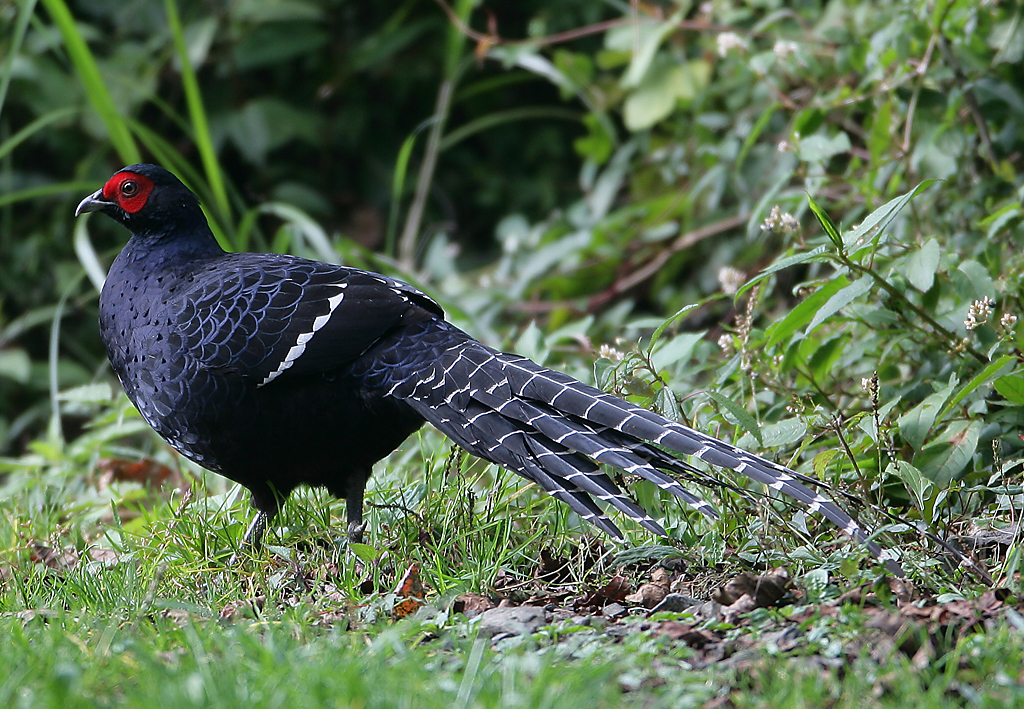
"Mikado Pheasant 398" by Snowyowls (photographer) / Jako (uploader)
- own work (by Snowyowls) from zh wiki. Licensed under CC BY-SA 3.0 via Commons.
of areas containing Mikado Pheasants (Syrmaticus mikado) to determine the total land area available to this endemic, mountainous species. This information is needed for locating additional populations of the pheasant and for determining its IUCN status of extinction risk. Syrmaticus mikado have been observed along roads and trails passing through primary, secondary, and managed forested and grassland habitats between the elevations of 1600 and 3300 m. In Taiwan, the extent of these habitats between the elevations of 1600-3300 m amounts to 205,181 ha. Of this, 52% (105,733 ha) is protected within three national parks, five protected areas, and seven nature reserves. Based on these general estimates, S.mikado should not be considered an endangered species. This conclusion should be taken with caution, however, as not all the area described here may be suitable, and actual conditions within protected areas are unknown.The dilemma of all conservation biologists is that of funding and time. Currently there is much effort in developing models that may help predict the status of species or their risk of extinction (e.g. Ratner et al. 1997, Vucetich et al. 1997, and Findlay & Houlahan 1997) and that may help determine geographic locations or hot spots that need protection in order to conserve a species or group of species (e.g. Kiester et al. 1996, Brooks et al. 1997). Only recently have Geographic Information Systems (GIS) begun to play a role in the creation and testing of these models. Meanwhile, there is a great deal of work being done to determine or estimate the distribution and status of species of concern (papers in Jenkens 1993). Increasingly, GIS is being used to correlate habitat with distribution (e.g. Knick & Dyer 1997, Waller & Mace 1997). The International Union for Conservation of Nature and Natural Resources (IUCN) has recently published revised Red List categories (Species Survival Commission 1994). Species are placed into certain threat categories (critically endangered, endangered and vulnerable) based on the status of their population, if known, or the extent and status of their distribution range, described as extent of

Female Mikado Pheasant
occurrence. Estimating the extent of occurrence and determining that this range is either fragmented or declining is one way to place a species within the three categories of threat listed by the Species Survival Commission (1994). A species is considered critically endangered if the extent of its occurrence is less than 100 km2. It is listed as endangered if the extent of its occurrence is less than 5000 km2, and it is considered vulnerable if less than 20,000 km2. For all three categories, the amount of habitat within this range, or the population of the species itself, must also be demonstrated to be fragmented or declining (Species Survival Commission 1994). Most Galliformes are naturally rare and have limited ranges (King 1981), a fact which greatly increases theirrisks of extinction (Simberloff 1994). Of all the bird orders, the order Galliformes has the third highest number of threatened species (64), following the passerines (497) and parrots (71). Hunting pressure and habitat loss account for 63% of the threats to Galliformes (data compiled from King 1981). Of the pheasant species within this order, 96% are threatened by hunting or habitat loss, and the habitat requirements of 17% have yet to be studied at all (McGowan & Garson 1995). It is only recently that Syrmaticus mikado has been classified as safe (McGowan & Garson 1995), upgraded from threatened with extinction (Groombridge 1993-1994). The pheasant is endemic to Taiwan and is still considered endangered in Taiwan (Lee & Yang 1993). Therefore, the status of this species remains in debate. Here, we develop a GIS model of S. mikado habitat to estimate the extent of occurrence as an initial step towards determining this species' category of threat. This model is based on the assumptions that the pheasant is found only in forested and grassland habitat between 1600 and 3300 m in elevation. These assumptions can only estimate the maximum amount of habitat available to the bird; it is unlikely that it occurs in all habitats described in this model. Further study of habitats actually used by the pheasant and of its population demographics are needed to refine and to test the utility of such a rough model for use with S. mikado or other species. Source: Article. King Cockatoo Probosciger Aterrimus Palm Cockatoo: Palm Cockatoo Or Probosciger Aterrimus , or in

derivative work: Snowmanradio (talk) - originally posted to Flickr as Palm Cockatoo (Probosciger aterrimus)
and uploaded to commons at Probosciger_aterrimus_-Melaka_Zoo-8a.jpg. Licensed under CC BY 2.0 via Commons.
scientific name is Probosciger aterrimus bittern black cockatoos and large, with a length of about 60cm. This bird has a red cheek skin and large beak blackish color. On their heads is large crest which can beenforced. Female birds are similar to male birds. Palm Cockatoo is the only bird in a single clan Probosciger.Regional distribution of this bird is on the island of New Guinea and northern Australia. Palm Cockatoo bird feed consisting of grains. Palm Cockatoo bird's beak can not be closed, due to the size of half of the top and bottom are different. And it's handy to hold and open the grain to be consumed. Although the species is threatened by loss of forest habitat and illegal arrests continuing to trade, Palm Cockatoo is often found in their habitat. Palm Cockatoo evaluated as low risk on the IUCN Red List. The species is listed in CITES Appendix I. Palm Cockatoo or in scientific name is Probosciger aterrimus bittern, black cockatoos and large, with a length of about 60cm. This bird has a red cheek skin and large beak blackish color. On their heads is large crest which can be enforced. Female birds are similar to male birds. Palm Cockatoo is the only bird in a single clan Probosciger. Regional distribution of this bird is on the island of New Guinea and northern Australia. Palm Cockatoo bird feed consisting of grains. Palm Cockatoo bird's beak can not be closed, due to the size of half of the top and bottom are different. And it's handy to hold and open the grain to be consumed. Source: Article, Image, Bird's Head Color Determines Its Personality: UK researchers have shown

"Male adult Gouldian Finch" by Martin Pot (Martybugs at en.wikipedia). Licensed under CC BY-SA 3.0 via Commons.
Gouldian finches . Copyright Nigel Jacques.
that highly sociable Australian birds, called Gouldian finches, have different personalities according to the colour of their heads.The team, led by Leah Williams and Dr Claudia Mettke-Hofmann from Liverpool John Moores University, found that red-headed birds have aggressive tendencies, while those with black heads are bold and take more risks than their peers. This is only the second study to show a strong link between personality and colour. "We think that head colour is used as a signal of personality to other birds in the flock, so they know who to associate with," says Williams, who studied the birds as part of her PhD project. Williams and animal personality expert Mettke-Hofmann teamed up with Dr Andrew King from the Royal Veterinary College to find out if colour reflects personality in the endangered Gouldian finch. Gouldian finches have extremely colourful plumage with either red, black, or - rarely - yellow-coloured heads. They live in open, subtropical woodland, where they nest in loose colonies, feeding mainly on grass seeds. Williams, King and Mettke-Hofmann decided to measure three aspects of personality - aggression, boldness and risk-taking - in the finches. They tested the birds' tendency to investigate an unfamiliar object, in this case grey or brown bundles of string dangling from a perch, to find out how bold they were. To test for risk-taking behaviour, they presented both kinds of birds with a cardboard cut-out silhouette of a typical predator like a hawk. For aggression, they put a feeder out for two hungry birds, but the feeder only had room for one bird to eat. They wanted to see which birds would demonstrate aggressive behaviour to get at the food on offer. They found that red-headed birds are quicker to displace each other, or display threatening behaviour with an open beak than the black-headed finches are, exhibiting a fiery personality. They also found that birds with black heads returned to feeders after being shown the hawk silhouette much sooner than red-headed birds did, revealing a risk-taking personality. Black-headed birds were also more likely to approach and touch the string before a red-headed finch would. "We think that having head colour reflect personality means birds can more easily choose who to associate with, and who to avoid in large flocks," says King. The researchers say their findings may explain differences in colours. "Different colours may mean each bird uses different behavioural tactics," says Mettke-Hofmann. "The next step is to find out which birds associate with which. Do reds hang out with reds or blacks and do they do better for that?" asks Williams. The study was funded by the Higher Education Funding Council for England (HEFCE) and the Natural Environment Research Council (NERC). Contacts and sources: Natural Environment Research Council , Leah Williams (primary contact), Liverpool John Moores University, Dr Andrew King, The Royal Veterinary College, Dr Claudia Mettke-Hofmann, Liverpool John Moores University, Source: Nano Patents And Innovations
Mating

"Peacock by Nihal Jabin" by NIHAL JABIN - Own work. Licensed under CC BY-SA 3.0 via Commons.
village. "The government has decided to set up a breeding centrefor the national bird in the village. It is common to spot over a dozen peacocks in any part of the village, which is a rare thing," said L.B. Manjhi, a forest official. State Chief Wildlife Conservator B.N. Jha last week directed the district forest department to prepare a blueprint for developing the village as a peacock breeding centre. "Forest officials have already begun work in this regard," Manjhi said. According to the official, the forest department is likely to use a vacant plot of land belonging to the water resources department for this purpose. "A wide picket fence would be developed and a pond dug in the area," he said. Another official said plantation of saplings within the area and around the pond is also being planned so that peacocks could hatch their eggs there. Last year, Chief Minister Nitish Kumar had visited the village, spread over 700 acres, and directed the authorities to take steps to protect peacocks and facilitate their safe breeding. A couple of peacocks were first brought to the village in 1950 by one Chandrika Singh, according to a forest official. "The number of the birds has swelled over the years. Since there are restrictions against their domestication, the villagers have jointly provided a number of shelters for the birds," the official added. The villagers have also taken the responsibility of protecting the birds from animals and poachers. A pond has been dug in the village especially for the use of peacocks. Most of the birds have become friendly with the humans and they co-exist peacefully. Source: Article, Image. Do Birds Have Penises?: Most of us have heard the song, “Birds Do It, Bees Do It” but have you every really thought about how a bird fits tab A into slot B? Let’s look at the equipment. Most birds do not have a penis. Most birds have a little lump called a cloaca. During the breeding season when hormones are flowing the
cloaca swells and birds can get a cloacal protuberance. Above, a bird bander blows on a Tufted Titmouse belly and note the spot below the bare patch–that’s a cloaca. Both sexes have the cloaca, so for most birds sex literally is about bumping uglies. They do not have lengthy love making periods, but fast 1 to 3 second copulations that can happen hundreds of times a day. With birds, it’s generally not about quality, it’s about quantity. However, for a few species, things gets…weird. For example, the Red-billed Buffalo Weaver has a pseudo-penis, not quite a cloaca, not quite a penis. He will rub this against the female’s genitalia for 10 to 20 seconds and this is supposed to
Cassowary photo by Bjørn Christian Tørrissen via Wikipedia. Beneath that comical exterior lies a super freak of Rick James proportions.
increase the chances that his sperm will stay. Cassowaries give the Buffalo Weaver a run for his money as both sexes have a penis and clitoris. But the freakiness doesn’t end there. Both male and female birds have a phallus but it’s not connected to reproductive tissue in either bird. When the male Cassowary inserts what looks like a
penis into female, the semen ejaculates from the cloaca from the base, not the tip. All looks quiet and cute for this the Blue-winged Teal pair, but what kinky escapades could they be capable of? But the bird that takes genitalia to a whole new level is the duck. Some people get upset when they see several males gang up on one female (or in some cases a young male) but underneath the feathers of both sexes is a sexual arms race of epic proportions that’s been waging for thousands of years. It may look like the males are harming the females but they have their own arsenal of weaponry that James Bond (the spy, not the ornithologist) would envy. Male ducks have an actual penis, but it’s not an ordinary penis, it’s an explosive spiral penis and in some cases it’s spiny (not necessarily for her pleasure). By bird standards it’s huge and some species go the extra mile like the Argentinian Lake Duck with its over 16 inch long member (when stretched out, is a little longer than the duck itself). So, why would a male duck need such a crazy appendage that works at lightning speed to mate with a female? Hens can have a vagina that has multiple compartments and dead ends, kind of like a labyrinth only without Muppets and David Bowie. By closing off certain pockets, she can control where the ballistic spiral penis deposits the semen. Some studies even suggest that most of the forced copulation by males results in their deposits going no where. Like any healthy bird, she wants to make sure that she gets the best of the best when that appendage fertilizes her eggs. Considering how it is so different from the cloacas other birds use to make eggs, researchers have been fascinated and wanted to know more.? Source: Article. Do Birds Mate in the Air: A bird that mates in the air is
"PeregrineFalconSilhouettes" by Shyamal - Own work. Licensed under Public Domain via Commons.
the falcon, which flies to the highest height it can and mates while falling down to the ground. Explore the mating habits of various birds with tips from a pet store employee in this free video on types of birds. Source: Article, Image, Wild Bald Eagles Reproduction: Bald Eagles are sexually mature at four or five years of age. When
they are old enough to breed, they often return to the area where they were born. It is thought that Bald Eagles mate for life. However, if one member of a pair dies or disappears, the other will choose a new mate. A pair which has repeatedly failed in breeding attempts may split and look for new mates. Bald Eagle courtship involves elaborate, spectacular calls and flight displays. The flight includes swoops, chases, and cartwheels, in which they fly high, lock talons, and free fall, separating just before hitting the ground. Usually, a territory defended by a mature pair will be 1 to 2 km (0.62 to 1.2 mi) of waterside habitat Compared to most other raptors which mostly nest in April or May, bald eagles are early breeders: nest building or reinforcing is often by mid-February, egg laying is often late February (sometimes during deep snow in the North), and incubation is usually mid-March and early May. Eggs hatch from mid April to early May, and the young fledge late June to early July. The nest is the largest of any bird in North America; it is used repeatedly over many years and with new material added each year may eventually be as large as 4 meters (13 ft) deep, 2.5 meters (8.2 ft) across and weigh 1 metric ton (1.1 short tons); one nest in Florida was found to be 6.1 meters (20 ft) deep, 2.9 meters (9.5 ft) across, and to weigh 3 short tons (2.7 t). This nest is on record as the largest tree nest ever recorded for any animal. Usually nests are used for under five years or so, as they either collapse in storms or break the branches supporting them by their sheer weight. However, one nest in the Midwest was occupied continuously for at least 34 years without interruption. The nest is built out of branches, usually in large trees found near water. When breeding where there are no trees, the Bald Eagle will nest on the ground, as has been recorded largely in areas largely isolated from terrestrial predators, such as Amchitka Island in Alaska. In Sonora, Mexico, eagles have been observed nesting on top of Hecho catcuses (Pachycereus pectinaboriginum). Nests located on cliffs and rock pinnacles have been reported historically in California,Kansas, Nevada, New Mexico and Utah, but currently are only verified to occur only in Alaska and Arizona. The eggs average about 73 millimeters (2.9 in) long, ranging from 58 to 85 mm (2.3 to 3.3 in), and have a breadth of 54 millimeters (2.1 in), ranging from 47 to 63 cm (19 to 25 in). Eggs in Alaska averaged 130 g (4.6 oz) in mass, while in Saskatchewan they averaged 114.4 g (4.04 oz). As with their ultimate body size, egg size tends to increase further away from the Equator. Eagles produce between one and three eggs per year, two being typical. Rarely, four eggs have been found in nests but these may be exceptional cases of polygyny. Eagles in captivity have been capable of producing up to seven eggs. Source: Article, Image, Antarctic Albatross Displays Shift In Breeding Habits: A new study of the wandering albatross –
Wandering albatross: Credit: Wikipedia
one of the largest birds on Earth – has shown that some of the birds are breeding earlier in the season compared with 30 years ago. Reporting online this month (April) in the journal Oikos, a British team of scientists describe how they studied the breeding habits of the wandering albatross on the sub-Antarctic island of South Georgia. They have discovered that because some birds are now laying their eggs earlier, the laying date for the population is an average of 2.2 days earlier than before. The researchers say the reasons for this change are unclear. Lead author Dr Sue Lewis at the University of Edinburgh's School of Biological Sciences said, "Our results are surprising. Every year we can determine when the birds return to the island after migration, and the exact day they lay their egg. We knew that some birds were laying earlier – those who were older or had recently changed partner - but now we see that those which haven't bred successfully in the past are also laying earlier, and these birds are effectively driving this trend in earlier laying". The researchers studied over 30 years of data from birds located near the British Antarctic Survey's research station on Bird Island (part of South Georgia). Nest sites were monitored daily during the pre-laying, laying, hatching and fledging periods to document breeding patterns. Numbers of wandering albatrosses on South Georgia have been steadily declining largely because the birds swallow baited hooks on longlines set by fishing vessels, and are dragged under and drown. Despite a recent increase in breeding success over the last 20 years, the number of birds at Bird Island has fallen by over 50% since the 1960s, from 1700 to only 800 breeding pairs. British Antarctic Survey bird ecologist Dr Richard Phillips, also an author on the paper said, "This work is important for understanding more about the behaviour of these charismatic and threatened birds. In the Indian Ocean, an increase in the intensity of westerly winds has resulted in a shift in feeding distribution of wandering albatrosses. It is possible that earlier breeding in some females at South Georgia is a consequence of environmental change, but at the moment we are not sure if this is related to weather, a change in oceanographic conditions or food availability to which only some birds are responding." This research is a collaboration between the University of Edinburgh and British Antarctic Survey and was funded by the Natural Environment Research Council (NERC). Contacts and sources: Athena Dinar, British Antarctic Survey. Source: Nano Patents And Innovations. Australian Birds Attract Mates with "Scary Movie
Credit: Mitchell Walters/University of Chicago)
Effect": Using a horror film to bring your date closer is a classic move in the teenage playbook. Now, a study of Australian birds finds that other animals use the same "scary movie effect" to attract female attention, by hitchhiking mating signals onto the calls of predators. Male splendid fairy-wrens, a sexually promiscuous small bird native to Australia, are known to sing a special song each time they hear the call of one of their predators, the butcherbirds. New research from scientists at the University of Chicago finds that this seemingly dangerous behavior actually serves as a call to potential mates – a flirtation using fear. Published in the journal Behavioral Ecology, the study involved painstaking field research playing sound clips to splendid fairy wrens at a conservation center in Southern Australia. Experiments determined that the "vocal hitchhiking" of male birds is a courtship behavior that uses predator calls to grab the attention of female birds. "We have shown that females do, in fact, become especially attentive after hearing butcherbird calls," said Emma Greig, PhD, first author of the study and currently a postdoctoral researcher at Cornell University. "So, it seems that male fairy-wrens may be singing when they know they will have an attentive audience, and, based on the response of females, this strategy may actually work!" Splendid fairy-wrens are interesting to scientists studying evolution and mating patterns due to their unique social structure, said Stephen Pruett-Jones, PhD, associate professor of ecology and evolution and senior author of the study. While the birds are socially monogamous, forming male-female pairs that last their entire lives, they are sexually promiscuous, mating predominantly with birds outside of their home pair. After years of studying these birds and their close relatives, the superb fairy-wrens, researchers noticed the unique, consistent pairing of butcherbird calls with a unique fairy wren call known as Type II song. "The male begins his Type II call immediately after the butcherbird begins to call, so they're basically right on top of each other," Pruett-Jones said. "It sounds like a duet." But theories varied as to why fairy-wrens would risk exposing their location to a predator by singing. Was it an alarm call to other fairy-wrens in the area? A display of their bravery and physical fitness to attract mates? Or an effective means of capturing the attention of any females in the area? For the study, Greig played different combinations of songs from her iPod to male and female fairy-wrens in their natural habitat: the territorial Type I song, as well as the Type II song with and without the preceding predator call. The experiments found that females were most attentive – as measured by looking in the direction of the call and responding with their own song – when the butcherbird-preceded Type II song was played. The results suggest that males use the predator call as an "alerting signal," Pruett-Jones said, similar to how humans might capture another person's attention by starting their sentence with "Hey!". For the females, the signal may carry information about the location of potential mates in neighboring territories, and potentially may nudge them towards mating, Greig said. "The most exciting possibility is that Type II songs have a sexual function, and that females are more easily stimulated by, or receptive to, displays after being alerted by a predator, such that the male's song is especially attractive," Greig said. Ongoing research is measuring the physical attributes and genetics of male splendid fairy-wrens and their offspring to see if there is a connection between Type II singing and mating success. But so far, no link has been found between the behavior and physical health, suggesting that the Type II singing is not a self-imposed handicap to make males look more fit and attractive to females "All males, regardless of age, color, or other measures of individual 'quality,' gave Type II songs with equal frequency, which suggests that singing after a predator vocalizes may not be as costly a behavior as you might imagine," Greig said. "Contrary to what you might expect, singing after a predator call may actually be quite safe: the male fairy-wrens know where the predator is located, and he also knows that the predator isn't actively hunting at that moment, but is instead singing its heart out." Greig is also currently testing how common the "scary movie effect" is beyond the splendid and superb fairy-wrens. While only two other birds, fairy gerygones and white-throated magpie jays, are thought to demonstrate similar predator-elicited display, the researchers believe it may be present and undetected in other species as well. "We suspect it may be more common than previously appreciated. It's definitely rare, but people just haven't followed up in these other species to do these kinds of experiments," Pruett-Jones said. The University of Chicago Medical Center. Citation: Greig, E., & Pruett-Jones, S. (2010). Danger may enhance communication: predator calls alert females to male displays Behavioral Ecology, 21 (6), 1360-1366 DOI: 10.1093/beheco/arq155. Source: Nano Patents And Innovations
Climate
How birds cope with changing climate to avoid extinction: short-life, For small and lived birds, evolution can work fast enough for genetic adaptation to keep pace with a changing environment, a new study has revealed. In the analysis, based on more than fifty years' detailed study of a population of great tits near Oxford, UK, a team of scientists have found that even for such fast-evolving species, evolution
on its own is not enough. The study, conducted by scientists from the University of Oxford, found that individual birds have a built-in flexibility that enables them to adjust their behaviour rapidly in response to short-term changes in the environment. This flexibility-known as phenotypic plasticity-greatly increases the chances that a population can survive in spite of short-term changes, but that possibility depends on how closely they can track the key aspects of their environment, such as the availability of food. As species become longer-lived, and thus slower to reproduce, evolutionary adaptation is far slower and can't on its own save such species from climate change-induced extinction. The team combined their intensive study of the birds with data on how this key caterpillar food source has changed over time, allowing them to predict how well the birds can track the change in the environment through its effects on the caterpillar population. The study was published on July 9 in the open access journal PLOS Biology.(ANI). Source: Link1, Link2. Bluebirds egg on spring: A glorious, blue egg appeared on this 1st
day of spring in the bluebird nest on the quadrangle of Emory's Oxford Campus. The 
"Sarus Crane (Grus antigone) at Sultanpur I Picture 151" by J.M.Garg - Own work. Licensed under CC BY-SA 3.0 via Commons.
alternatively not-so- musical for most of their lifetime, their musical utterances at the moment of death have been suggested as the origin of the swan song legend. Much for the delight of ornithologists, this melodious rare winter migrant birdie- “whooper swan” is the new winged guest at Pong Dam Lake wetland this winter. A pair of whooper swans was spotted in the Nagrota Suriyan on January 29. The bird has been a rare migrant to India and has been recorded at Pong Dam for first time, while in India it was last recorded a century ago in 1900. “We recorded a pair of the whooper swan (pronounced as hooper). It was a chance discovery and we have taken some photographs of the bird as a proof,” said assistant conservator of forest (wildlife), Dharamsala, DS Dhadwal, adding that “the bird is a rare migrant to India and it normally migrates from Central Asia and Europe”. “The last record of this bird, shot on the river Beas is by EH Aitken in 1900 before that AO Hume has mentioned the bird in his notes on Swans of India in 1878,” said Dhadwal. Meanwhile, Dhadwal told that this was the 418th bird species to be recorded at the Pong Dam wetland, 417th being the “Ruddy Breasted Crake” recorded only last month. The reappearance of the whooper swan, with distinctive long thin neck and yellow bill, at the Pong wetlands has attracted the attention of ornithologists. "As soon as the news about the sighting of the swans flashed, the official present at the Pong Dam preparing the ongoing two day avian count race, got a number of enquiries from bird lovers across the country," Dhadwal said. The Red Data Book of the International Union for Conservation of Nature – a compendium of species facing extinction – has put the whooper swan in the least concern category. Amongst the heaviest flying birds, whooper swan has an average body weight of 9.8-11.4 kg for males and 8.2-9.2 kg for females, and has extremely large range. It prefers shallow freshwater pools, lakes, marshes and swamps. Whooper swans require large areas of water to live in, especially when they are still growing, because their body weight cannot be supported by their legs for extended periods of time. The whooper swan spends much of its time swimming, straining the water for food, or eating plants that grow on the bottom. Despite their size, whooper swans are powerful fliers and can migrate hundreds or even thousands of miles to their wintering sites in southern Europe and eastern Asia. The whooper swan is the national bird of Finland and is featured on the Finnish 1 euro coin. Source: Article. Mystery of monarch migration takes new turn: By Carol Clark: During the fall,

Sun beams light the wings of monarchs resting in a tree in Mexico. Photo by Jaap de Roode.
hundreds of millions of monarch butterflies living in eastern North America fly up to 1,500 miles to the volcanic forests of Mexico to spend the winter, while monarchs west of the Rocky Mountains fly to the California coast. The phenomenon is both spectacular and mysterious: How do the insects learn these particular routes and why do they stick to them? A prevailing theory contends that eastern and western monarchs are genetically distinct, and that genetic mechanisms trigger their divergent migratory paths. An analysis led by Emory University biologists, however, finds that the two groups of monarchs are genetically mixed. Their research, published in the journal Molecular Ecology, suggests that environmental factors may be the key to the

Fluttering monarchs fill the sky over Mexico. Photo by Jaap de Roode.
butterflies’ choice of winter homes, and to where they wind up in the spring. “Our data gives the strongest signal yet that the eastern and western monarchs belong to a single genetic population,” says Emory biologist Jaap de Roode, who led the research. “This distinction is important to help us better understand the behavior of the organism, and to conserve the monarch flyways.” In addition to researchers in the de Roode lab, the study involved a scientist from the Institute of Integrative Biology in Zurich, Switzerland. Biologists have long been fascinated by the innate and learned behaviors underlying animal migrations. When monarchs are breeding, for instance, they can live up to four weeks, but when they are migrating, they can live as long as six months. “As the day length gets shorter, their sexual organs do not fully mature and they don’t put energy into reproduction. That enables them to fly long distances to warmer zones, and survive the winter,” de Roode says. “It’s one of the basic lessons in biology: Reproduction is very costly, and if you don’t use it, you can live much longer.” Watch a YouTube video of monarchs gathering in Mexico, narrated in Spanish by Mexican actor Alan Estrada: Mass movements of animals have huge ecological impacts. They are also visually arresting, from the spectacle of giant herds of wildebeest trekking across the Serengeti to hundreds of thousands of sandhill cranes flocking along the banks of Nebraska’s Platte River. In the case of long-lived mammals and birds, the younger animals may learn some of the behaviors associated with migration. That’s not the case with the monarchs, notes Amanda Pierce, a graduate student in Emory’s Population Biology, Ecology and Evolution program, and a co-author of the study. “We know there is no learning component for the butterflies, because each migration is separated by two to three generations,” Pierce says. “To me, that makes the problem even more interesting. How can these small, delicate animals

A tree in Mexico wears a fluttering cloak of monarchs. Photo by Jaap de Roode.
travel thousands of kilometers and arrive at the same destination as their great-great grandparents?” The question of whether eastern and western monarchs are genetically the same has been hotly debated, and may be an essential piece to the puzzle of their divergent migration patterns. The researchers used 11 genetic markers to compare the genetic structures of eastern and western monarchs, as well as non-migratory monarch populations in Hawaii and New Zealand. The results showed extensive gene flow between the eastern and western monarchs, and a genetic divergence between these North American butterflies and those from Hawaii and New Zealand. “In a sense, the genetic markers provide a DNA ‘fingerprint’ for the butterflies,” de Roode says. “Just by looking at this fingerprint, you can easily separate the butterflies of North America from those in Hawaii and New Zealand, but you can’t tell the difference between the eastern and western monarchs.” The Emory researchers have now joined a project headed by Harvard, which also involves the University of Georgia and the University of Massachusetts, to sequence the full genomes of monarch butterflies from places around the world. That data should rule out genetic differences between the

Pismo Beach is a California overwintering site for monarchs. Photo by Jaap de Roode.
eastern and western monarchs, or reveal whether any smaller genetic differences, beyond the 11 markers used in the study, may be at play between the two groups. The idea that eastern and western monarchs are distinct populations has been bolstered by tagging-and-tracking efforts based in the United States. That data, gathered through citizen science, indicates that the butterflies stay on separate sides of the Rocky Mountains – a formidable high-altitude barrier. De Roode, however, theorizes that when spring signals the eastern monarchs to leave the overwintering grounds in Mexico, they may simply keep radiating out, reproducing and expanding as long as they find milkweed plants, the food for their caterpillars. “Few people have tagged the monarchs within Mexico to see where they go,” he says, “because Mexico doesn’t have as much citizen science as the U.S.” If the theory is correct, some of the monarchs leaving Mexico each spring may wind up in western North America, while others may filter into the eastern United States. This influx to the western U.S. could be crucial to survival of monarchs on that side of the continental divide. “There are far fewer monarchs west of the Rockies,” de Roode says. He notes that all of the overwintering monarchs on a typical overwintering site along the California coast consist of about the same number clustered onto a single big tree in Mexico’s Monarch Butterfly Biosphere Reserve, where hundreds of millions of monarchs blanket the landscape in the winter. The monarch butterfly migration has been called an endangered phenomenon, due to the loss of habitat along the routes. The Mexican overwintering sites, located in the Trans-Mexican Volcanic Belt region northwest of Mexico City, particularly suffer from deforestation. Drug trafficking in the region has decimated eco-tourism and hampered efforts to protect the trees. “We hope our research can aid in the conservation of the monarch flyways,” de Roode says. Raising monarchs for release at weddings, memorials and other events is a growing industry, but U.S. Department of Agriculture regulations restrict shipping the butterflies across state lines. De Roode stresses that this regulation should remain in force, even if further research confirms that eastern and western monarchs are genetically identical, because parasites that the butterflies carry can differ by region. “It’s not a good idea to be shipping parasites around,” he says. Source: Article, Imperial Cormorant Dives Deep: researchers capture ride-along video of bird on the hunt: In the long

tradition of Greg Marshall's "Crittercam," researchers with the Wildlife Conservation Society and the National Research Council of Argentina were able to safely and securely attach a small video camera - often referred to as a "lipstick" camera because of its small size and lipstick case-like shape - to the back of an imperial cormorant. By doing so, they were able to document for the first time, a cormorant diving in search of food (successfully, I might add). The bird reached an approximate depth of 140 feet in as little as 40 seconds, with the camera recording the descent into darker and darker water and the cormorant cruising the bottom until it succeeds in snatching a small fish which it brought to the surface. Filmed in a coastal protected area in Patagonia, Argentina, the research involves studying where the birds hunt and feed so as to determine if there are any high priority feeding areas that may require additional protection. There are around 3,500 pairs of imperial cormorants in this particular location and since these birds do not migrate, how and where they feed becomes critical in providing any degree of conservation and protection. Source: Article. Less birds visit Okhla sanctuary this year, but number of species goes

"View of yamuna from okhla bird sanctuary" by Amit.pratap1988 - while travlling. Licensed under CC BY-SA 3.0 via Commons.
up: By Darpan Singh, There's bad news for the Okhla Bird sanctuary. Because of rising pollution, local disturbances and effects of climate change, nearly 3,200 less birds visited the sanctuary this winter. The annual Asian Waterbird Census (AWC), done in January this year, has put the total number of birds sighted at 5,545. Last year, the count was 8,751. The 2013 report has been prepared by Wetlands International (South Asia). TK Roy, Delhi state coordinator of AWC, told Hindustan Times, "The decline in the number of birds is because of climate change and several other local factors and threats. Yamuna is highly polluted. Something needs to be done urgently." But the number of species that visited the sanctuary this winter has gone up from 57 to 63. Besides, nearly 35 species have registered an increase in the number of birds. These include resident, migratory and local migratory species. The numbers of some bird species - such as Greylag Goose, Barheaded Goose, Com-mon Teal, Gadwal and Eurasian Wigeon - has gone up substantially. But about 20 species have registered a decline in their numbers. Some of them are: Northern Shoveler, Common Coot, Northern Pintail, Tufted duck and Common Pochar. Moreover, three bird species - Pied Avocet, Little Stint and Little Ringed Plover - gave the sanctuary a miss this winter. What was heartening was that the Greater Flamingo (26 in all) made a comeback after 2010 and a lone Common Shelduck returned after 12 years. "Coastal birds such as Greater Flamingo used to number around 500 at the sanctuary earlier but the number came down to 20 in 2010. These rosy-white, long legged birds gave the sanctuary a miss in 2011 winter, though in an unusual development, seven of them were found in the sanctuary this monsoon," Roy said. Bird lovers are also optimistic from the fact that some threatened species - such as Oriental Darter, Oriental White Ibis, River Lapwing, Painted Stork and Black-tailed Godwit - were sighted this winter. The sanctuary - spread over an area of 3.5 sqkm on the Yamuna - is a heaven for waterbirds and a favourite among birdwatchers with more than 300 species spotted so far. After the construction of a barrage and the resulting lake in 1986, birdwatching activity increased. Source: Article. Climate Adaptation Difficult For
Europe's Birds: For the past 20 years, has been getting warmer. Species of bird and butterfly which thrive in cool temperatures therefore need to move further north. However, they have difficulty adapting to the warmer climate quickly enough, as shown by new research published in the journal Nature Climate Change. Åke Lindström is Professor of Animal Ecology at Lund University, Sweden. Together with other European researchers he has looked at 20 years’ worth of data on birds, butterflies and summer temperatures. During this period, Europe has become warmer and set temperatures have shifted northwards by 250 km. Bird and butterfly communities have not moved at the same rate. “Both butterflies and birds respond to climate change, but not fast enough to keep up with an increasingly warm climate. We don’t know what the long-term ecological effects of this will be”, says Åke Lindström. Butterflies have adapted more quickly to the changing temperatures and have moved on average 114 km north, whereas birds have only moved 37 km. A likely reason is that butterflies have much shorter lifespans and therefore adapt more quickly to climate change. Because birds like to return to the same breeding ground as in previous years, there is also greater inertia in the bird system. “A worrying aspect of this is if birds fall out of step with butterflies, because caterpillars and insects in general represent an important source of food for many birds”, says Åke Lindström. Sweden shows the strongest trends with regard to birds; however, there is no corresponding Swedish data for butterflies. For the study, the birds have been divided into ‘cold’ and ‘warm’ species, i.e. birds that thrive in slightly cooler or warmer temperatures. For example, chaffinches and reed buntings are ‘colder’ species and blackcaps and goldfinches ‘warmer’ species. In general, the researchers have observed that ‘warm’ birds are on the increase and ‘cold’ birds are in decline. When new species are seen in an area and others disappear, it is more often ‘warm’ species that arrive and ‘cold’ species that disappear. “Over the past 50 years the main factors affecting bird and butterfly numbers and distribution have been agriculture, forestry and urbanisation. Climate change is now emerging as an increasingly important factor in the development of biodiversity”, says Åke Lindström, continuing: “For Sweden, this will probably mean more species of bird in the long run; many new species are already arriving from the continent.” Åke Lindström works among other things on the projects BECC (Biodiversity and Ecosystem Services in a Changing Climate) and CanMove (Centre for Animal Movement Research) at Lund University in Sweden. The study is a joint European project with data from 20 years and seven countries (Spain, France, the Netherlands, Sweden, the UK, Finland and the Czech Republic). The Swedish data covers birds and temperatures and has been gathered on behalf of the Swedish Environmental Protection Agency. Contacts and sources: Åke Lindström, Source: Nano Patents Innovations. Declining Rainfall Is A Major Influence For
Credit: Dan Pancamo
Migrating Birds Find Smithsonian Scientists: Instinct and the annual increase of daylight hours have long been thought to be the triggers for birds to begin their spring migration. Scientists at the Smithsonian Conservation Biology Institute, however, have found that that may not be the case. Researchers have focused on how warming trends in temperate breeding areas disrupt the sensitive ecology of migratory birds. This new research shows that changes in rainfall on the tropical wintering grounds could be equally disruptive. The team's findings are published in scientific journal Proceedings of the Royal Society B, today, March 30. Many of the bird species that breed in the temperate forests, marshes and backyards of North America spend the winter months in the tropics of the Caribbean, and Central and South America. Insects are the primary food for many birds during the winter, and rainfall largely determines the amount of insects available. Climactic warming, however, is causing declining and more variable rainfall cycles in many areas, affecting the availability of insects and delaying when birds leave for their northern breeding grounds. To examine
Credit: Jeanner
this, the Smithsonian scientists focused on American redstarts (Setophaga ruticilla), a member of the warbler family, at a non-breeding site in Jamaica where they conduct long-term studies. "American redstarts were a perfect species for this study since they defend exclusive territories throughout the non-breeding period until they depart for spring migration and most return back to the same territory the following year," said Pete Marra, research ecologist at the Smithsonian Conservation Biology Institute's Migratory Bird Center. "These behaviors made it relatively easy to keep track of individual birds over multiple years and document changing spring departures. Each individual was fitted with a unique combination of colored leg bands." Precipitation in Jamaica is highly seasonal, with consistent rainfall from September to November and a pronounced dry season from January to March. The scientists observed the redstarts in their non-breeding territories for five years during the dry season. They paid special attention to the annual variation in dry season rainfall. The correlation between the amount of insects in a bird's territory and the timing of its departure suggested to the team that annual variation in food availability was an important determining factor in the timing of spring Normally flooded, this mangrove ecosystem is running dry due to a lack of rainfall. Smithsonian scientists found that this early drying may spur the
Credit: Ram Papish
American redstart to begin its spring migration. Had the redstarts relied on internal cues alone to schedule their spring departure, they would have all left their winter territories at the same time each year. "Our results support the idea that environmental conditions on tropical non-breeding areas can influence the departure time for spring migration," said Colin Studds, a postdoctoral fellow at the Smithsonian Conservation Biology Institute's Migratory Bird Center and lead author of the study. "We found that the same birds changed their spring departure from one year to the next in relation to the amount of rainfall and food in March." During the past 16 years, the dry season in Jamaica has become both increasingly severe and unpredictable, leading to an 11 percent drop in total rainfall during the three-month annual drought. Making the future even more dire, climate models predict not only increased warming on temperate breeding areas but also continued drying in the Caribbean. A critical question for the scientists is whether this variation in the onset of spring migration carries consequences for the birds. Delaying departure could be beneficial if food resources are low and the individual has not yet stored enough energy to migrate. However, delaying departure could affect arrival time to its breeding territory and result in less time to successfully reproduce. "Because American redstarts return to the same site to breed each year, arriving later may make it harder for them remain to remain in synch with their breeding cycle," Studds said. Contacts and sources: John Gibbons, Smithsonian. Source: Nano Patents And Innovations
Media
 follow the aircraft on their southern migration to Central Asia. Putin has won many admirers with his feats, that have left others less than impressed, starting from 2000 when he flew into Chechnya in the back seat of a fighter jet. He followed it up over the years, with a bare-chested horseback ride through mountains, a Formula One race car drive and piloting a firefighting plane to dump water on wildfires. The flight in the hang glider though hardly cut any ice with the cranes as only one bird followed Putin on his first flight. He attributed it to high winds that caused the hang glider to travel faster than the birds, RIA Novosti news agency reported. He was followed by five birds in his next flight, but after a few circles only two stuck with him through the 15-minute flight. Putin took time off to visit the Kushavet ornithological research station on the Yamal Peninsula in the Russian Arctic on Wednesday on his way to an international summit in Vladivostok, on Russia's Pacific coast. At the station, he set off with a pilot, who sat behind him on the hang glider, as they took the birds for a spin. It was a scene on the lines of one in the 1996 movie Fly Away Home, in which an estranged father and daughter use an ultralight plane to help a flock of geese migrate. The movie though, depicted the efforts of a real-life Canadian, who spent a decade teaching orphaned geese how to fly south. Putin's efforts had an altogether undesired side effect, as a biology student at the station claimed online that two chick cranes died and several others were hurt in the rush to ready for Putin's arrival. ''One of the chicks got into a hang glider's propeller while training and waiting for Putin," Mariya Goncharova wrote on her page on the Russian social networking website, vk.ru. ''One more broke a beak and stripped its claws off on bad netting, and many simply flayed themselves'' during their transport in boxes to the flight venue. According to Russian biologists less than 20 Western Siberian white cranes are left in the wild worldwide. Putin's flight spun off many a contemptuous joke on the internet though, one of the most popular being ''So Putin is off to wintering with cranes. Does this mean he's not going to be back before spring?'' Putin who is a month short of his 60th birthday, has cultivated an image as an animal lover during his time at the top of Russian politics, even getting a tiger cub as a birthday present. During a televised phone-in last year, when he was prime minister, replying to a viewer who asked him why he looked more comfortable with tigers and leopards than with his own ministers, he said, "The more I know people, the more I like dogs," paraphrasing the greek philosopher Diogenes. "I simply like animals." Putin's stunts have not gone down well with many and there was widespread disbelief in 2008 when he appeared to save a television crew from a rare Amur tiger in far eastern Russia by shooting it with a tranquilliser gun. The Kremlin's press service was also forced to admit the set up which showed footage and photographs of Putin striding away from a dive in the Black Sea after having recovered Greek amphorae was a set up, with the jars having been planted on the sea floor. A row about Putin's date with the endangered cranes had already erupted before the official confirmation of the stunt. Masha Gessen, chief editor of Russia's oldest scientific magazine, Vokrug Sveta, resigned on Monday after she resisted pressure to send a reporter to cover the event. "I'm leaving Vokrug Sveta #thankstoPutinforthat", Gessen tweeted later that day. She added she considered the request to publish material about Putin's involvement with the Siberian white cranes as "editorial interference". The outspoken journalist has also authored a critical biography of Putin that was released last year titled. Source: Article. Oldest Bird in U.S. Is a Mom at 60 Years Old, Laysan Albatross Named Wisdom: The oldest known U.S. wild bird – a coyly conservative 60 -- is a new mother. The bird, a Laysan albatross named Wisdom, was spotted a few weeks ago with a chick by John Klavitter, a U.S. Fish and Wildlife Service biologist and the deputy manager of the Midway Atoll National Wildlife Refuge. The bird has sported and worn out 5 bird bands since she was first banded by U.S. Geological Survey scientist Chandler Robbins in 1956 as she incubated an egg. Chandler rediscovered Wisdom in 2001. In 1956, he estimated Wisdom to be at least 5 years old then since this is the earliest age at which these birds breed, though they more typically breed at 8 or 9 after an involved courtship lasting several years. This means, of course, that Wisdom is likely to be in her early sixties. There must be something to all that fish oil she consumes because Wisdom does not look her age . "She looks great," said Bruce Peterjohn, the chief of the North American Bird Banding Program at the USGS Patuxent Wildlife Research Center in Laurel, Md. "And she is now the oldest wild bird documented in the 90-year history of our USGS-FWS and Canadian bird banding program," he added. "To know that she can still successfully raise young at age 60-plus, that is beyond words. While the process of banding a bird has not changed greatly during the past century, the information provided by birds marked with a simple numbered metal band has transformed our knowledge of birds." Wisdom, Peterjohn said, has likely raised at least 30 to 35 chicks during her breeding life, though the number may well be higher because experienced parents tend to be better parents than younger breeders. Albatross lay only one egg a year, but it takes much of a year to incubate and raise the chick. After years in which they have successfully raised and fledged a chick – which on Midway is about two-thirds of the time – the parents may take the occasional next year off from parenting. Klavitter said that Wisdom also nested in 2006, 2008, 2009 and 2010. And since adult albatross mate for life, with both parents raising the young, it makes one wonder if Wisdom has had the same partner all these years or not. Almost as amazing as being a parent at 60 is the number of miles this bird has likely logged – about 50,000 miles a year as an adult – which means that Wisdom has flown at least 2 to 3 million miles since she was first banded. Or, to put it another way, that's 4 to 6 trips from the Earth to the Moon and back again with plenty of miles to spare. One reason for all these miles is that Laysan albatross spend the first 3 to 5 years after fledging at sea, never touching land. Then they return to breed in the northwestern Hawaiian Island chain but some of their feeding grounds are actually off the coast of western North America, including the Gulf of Alaska. The parents tend to feed closer to the islands where their nests are when the chicks are very young, but they regularly commute to the northern Pacific Ocean and even the Gulf of Alaska when the chicks are older or when the adults are incubating. They convert the fish eggs and squid oil they eat into a rich, oily liquid, which they regurgitate and feed to their chick. In the non-breeding part of the year, albatross do not touch land -- the birds, scientists believe, often even sleep while flying over the ocean. Peterjohn noted that Wisdom's remarkable record is just one example of the valuable data provided by bird banding. In addition to establishing longevity records for birds, banding data from the North American Bird Banding Program documents migratory patterns, provides critical harvest and survival information used to manage populations of migratory game birds, and supports research activities on many issues from toxicology to disease transmission and behavior. Since 1920, approximately 64.5 million birds have been banded by this Interior Department-Canadian Wildlife Service program, and of those, nearly 4.5 million bands have been recovered. About albatross: Albatross are legendary birds for many reasons – in Samuel Coleridge's poem, "The Rime of the Ancient Mariner," a sailor has to wear an albatross around his neck as punishment for killing the bird. According to seafaring legends, albatross are the souls of lost sailors and should not be killed. However, as reported by James Cook, sailors regularly killed and ate albatross. Albatross are remarkable fliers who travel thousands of miles on wind currents without ever flapping their wings. They do this by angling their 6-foot wings to adjust for wind currents and varying air speeds above the water. Nineteen of 21 species of albatross are threatened with extinction, according to the International Union for the Conservation of Nature. Present threats to the birds include lead poisoning of chicks on Midway from lead paint used in previous decades; longline fishing, where the birds are inadvertently hooked and drowned, though conservation groups have banded with fishermen and dramatically lowered the number of deaths from this cause; and pollution, especially from garbage floating on the ocean. The birds ingest large amounts of marine debris – by some estimates 5 tons of plastic are unknowingly fed to albatross chicks each year by their parents. Although the plastic may not kill the chicks directly, it reduces their food intake, which leads to dehydration and most likely lessens their chance of survival. In addition, albatross are threatened by invasive species such as rats and wild cats, which prey on chicks, nesting adults and eggs. Albatross evolved on islands where land mammals were absent, so have no defenses against them. Contacts and sources: Bruce Peterjohn, Source: ineffableisland.com/. A Tale of Two Cockatoos: Here is an animated  video about Carnaby's and Baudin's cockatoos. It was devised by Gill Ainsworth, a PhD candidate who explored how the two species of cockatoo are valued differently by Australian society and why Carnaby's receives far more attention than Baudin's. Both species require urgent conservation efforts so the video is another way to help raise awareness of their plight. Source: Article, Image. Humans, birds have brains that are wired in a similar way: A researchere from Imperial Colleg London and his colleagues have developed for the first time a map of a typical bird brain, 
"Blue-winged Warbler" by Wwcsig - self-made / http://www.pbase.com/wwcsig/image/59657656. Licensed under CC BY-SA 3.0 via Commons.
Scientists are studying how birds memorize songs in order to gain new insight into human memory.
Ph.D., researcher at the The Duke Institute for Brain Sciences, on his work with finches and what they can tell us about the human brain: What do birds and memory have in common? Songbirds are consummate memorizers, having to learn species-specific songs and remember them for the rest of their lives. Mooney studied interactions between a baby bird and their "tutor" bird, who would teach them the songs of their species. Traditionally, it's thought that early experiences in human babies and baby songbirds would affect the sensory areas of the brain before they later engage motor ones. In songbirds, the parts of the brain controlling motor functions are engaged even before they sing for the first time. Source: Article. Animals have personalities too…An individual's personality can have a big effect on their life.
Some people are outgoing and gregarious while others find novel situations stressful which can be detrimental to their health and wellbeing. Increasingly, scientists are discovering that animals are no different. A new study led by Dr Kathryn Arnold, of the Environment Department at the University of York has added important experimental evidence showing that animal personalities are reflected in their oxidative stress profiles. The research is published in the Journal of Experimental Biology. Dr Arnold teamed up with graduate student Katherine Herborn, at the Institute of Biodiversity, Animal Health and Comparative Medicine at the University of Glasgow, to classify the personalities of 22 greenfinches. They tested each bird's reactions to a novel situation by adding a brightly coloured cookie-cutter to each greenfinch's food bowl, and timing how long it took for the birds to pluck up courage to approach the food. The researchers found that the boldest birds took only a few seconds to overcome their
"Rose-ringed Parakeet eating leaves" by JayDalal5 - Own work. Licensed under CC BY-SA 3.0 via Commons.
prevent disease? Then watch what migratory birds eat during their stopovers on Block Island. Two University of Rhode Island scientists believe that birds choose certain berries because they offer protection against oxidative stress that occurs during long flights. Oxidative stress can lead to inflammation and a variety of diseases in birds and humans. The team's preliminary findings show that birds stopping over on Block Island favor the arrow-wood berry, which contains more anti-oxidants and pigments than the 11 other island berries studied by the researchers. Navindra Seeram, assistant professor of pharmacy and head of the Bioactive Botanical Research Laboratory at URI, and Scott McWilliams, URI professor of wildlife ecology and physiology, have teamed up to research migratory birds' eating habits and how their diets might be used to understand the role of berries rich in anti-oxidants in human health. Research has shown a diet rich in anti-oxidants can help prevent cancer and other serious illnesses. Seeram reported the findings today at the American Chemical Society's 239th national meeting in San Francisco. (Seeram will be interviewed about this on NPR's Science Friday, March 26.) ''We're suggesting that birds choose deeply colored berry fruits in part because of their anti-oxidant properties,'' Seeram said. About 11 years before Seeram arrived at URI, McWilliams began laying the foundation for the recent study. ''When I started studying birds during their migratory stopover on Block Island, I was impressed that most of the migratory birds ate berry fruits even though they usually eat insects or seeds at other times of the year,'' said McWilliams, who came to URI in 1999. ''I began studying the relationship between the nutritional qualities of fruits and how those nutrients might fuel migration.'' When Seeram arrived at URI two years ago, McWilliams saw a University story online that detailed Seeram's research interests. ''I saw the story about Navindra and in it he was talking about oxidative stress and inflammation and the effects berry fruits can have on reducing those impacts on people.'' So McWilliams, who does his research and teaches in the College of the Environment and Life Sciences, tracked down Seeram, who works in the College of Pharmacy. They developed their mutual research interests into a successful collaboration that included URI graduate student Jessica Bolser and post-doctoral researcher Liya Li, who works in Seeram's lab. Called the lynchpin between McWilliams and Seeram, Bolser spent months in the field on Block Island observing the birds' nutritional patterns and collecting batches of 12 different kinds of berries for their analysis of anti-oxidant levels. The research indicates that birds prefer to eat certain fruits that have more antioxidants and key nutrients. In return, the seeds in the berries are dispersed by the birds. ''It's the way plants ensure their survival. Birds eat the berries, digest them and defecate the seeds over wide areas,'' McWilliams said. ''Meanwhile, the birds are attracted to the berries because of their rich color, which we believe is a plant's response to the stress of constant exposure to the sun and other stresses. Berry color could be a plant's way of fighting oxidative stress. It's a partnership that benefits plant and bird.'' The Seeram-McWilliams partnership will continue. ''We've only measured a few of these anti-oxidants,'' Seeram said. ''Our next step is to determine how birds can detect these compounds.'' ''Whenever we exercise, we undergo oxidative stress, and the same is true for birds,'' McWilliams said. ''We're flying birds in wind tunnels to produce oxidative stress, and then we are going to see if anti-oxidants found in these berries alleviate that stress,'' McWilliams said. The research may benefit human health as well as bird conservation. If further research shows the direct link between bird health and diet, then the findings will play a critical role in habitat protection for migratory birds, McWilliams said. ''That's what is so great about URI,'' Seeram said. ''Because the University is small, without the usual bureaucratic walls, we can create these partnerships. This collaboration between professors in two separate colleges would not have happened so easily in other universities and produced results so quickly.''Source: Article, Image. World's smallest egg found in Chongqing?:The world record for smallest egg might soon be broken after a new discovery in southwestern China's Chongqing Municipality. The chicken egg, which is about two centimeters long and weighs 2.58 grams, was laid on Monday by a Malaysian bantam owned by He Daiyou, a 55-year-old hairdresser from Shapingba District, Chongqing. The egg, less than half the size of a quail egg, has attracted media attention and surprised the owner. "The hen started to lay eggs last November, and it has laid about 150 normal eggs. The mini egg really surprised me, " He said on Friday. "I have looked into ways to declare to the Guinness World Records and I'm ready to give it a try," He added. He, a lover of cats, dogs and birds, bought the Malaysian bantam last year for 200 yuan (around 32 U.S. dollars). He sells small chickens that the bantam has hatched for between 80 yuan and 150 yuan. The world's smallest egg, which measures 2.1 centimeters in length and 3.46 grams in weight, is owned by Donnie Russell from West Virginia State, America, according to reports. Source: Article. Pigeon auctioned for $328,000: A sky- high price was paid for a pigeon during an online auction in Belgium. The buyer, Chinese shipping magnate Hu Zhen Yu, bought a pigeon for $328,000. Mr. Hu runs a shipbuilding company in China and is the owner of a South China pigeon-racing group. Source: Article. Remark: Open images in new tab or window to find it’s source of sharing, also get connect with each source of sharing articles via specified links. Our Sites unique and other links (if there will be any) are available just for the requirement of the subject not for increasing circulations, as we are not in the promotion of any kind its all for very special issues, personalities etc. |



